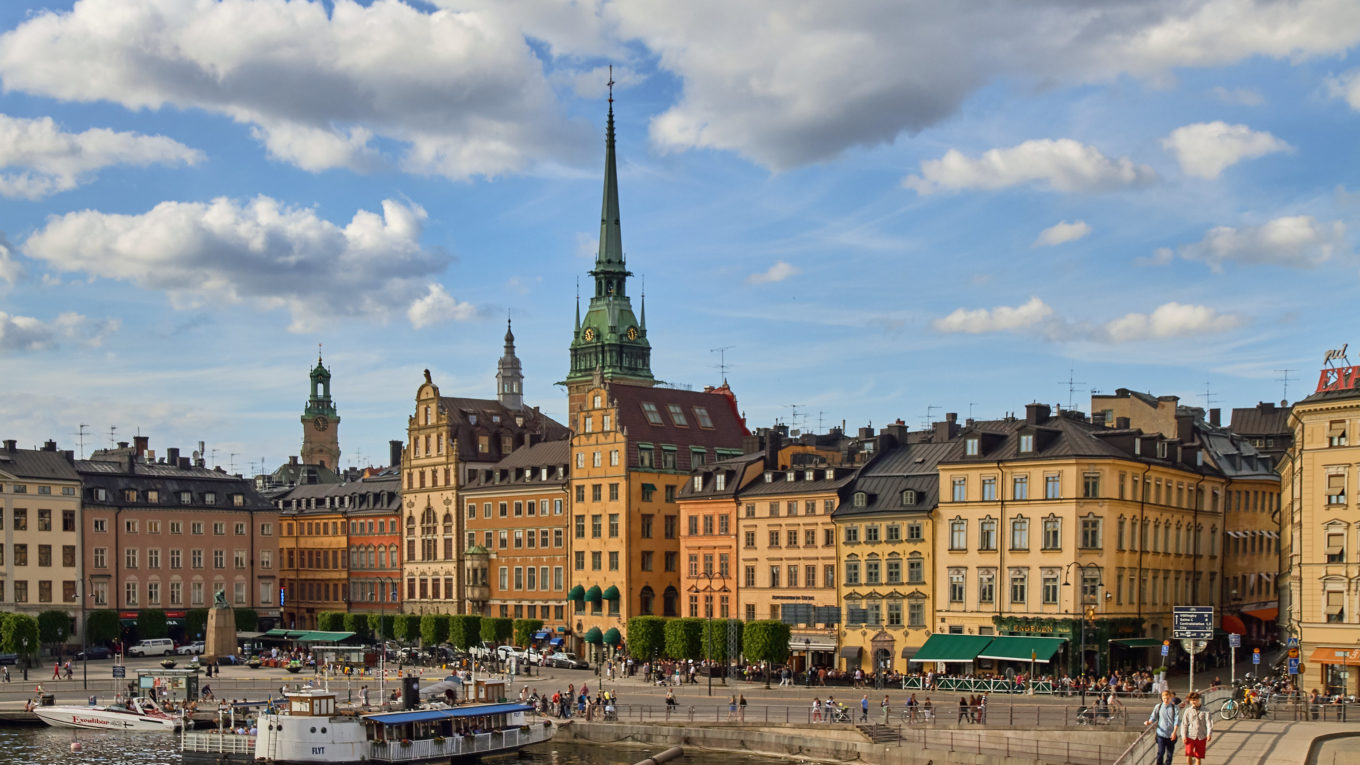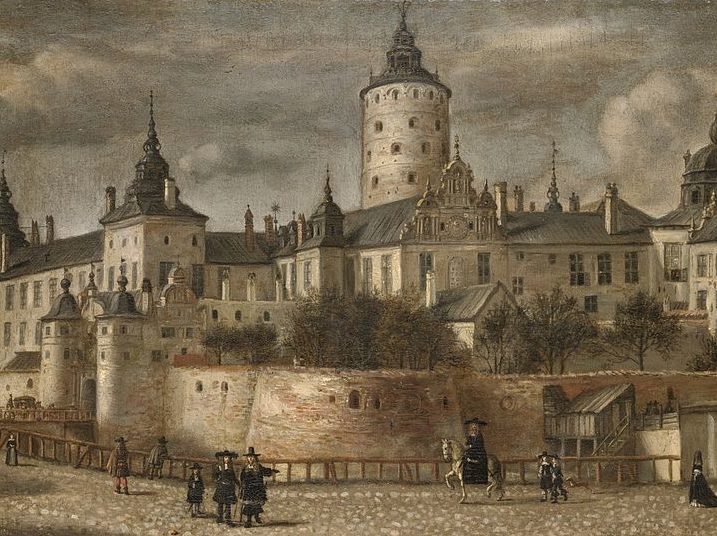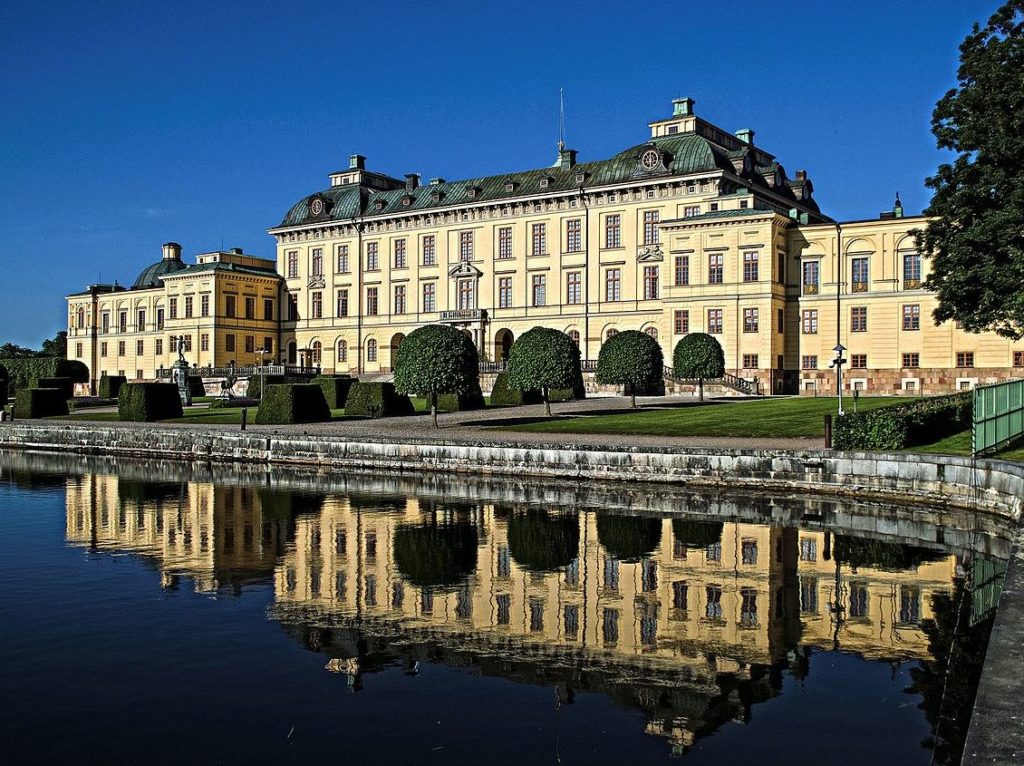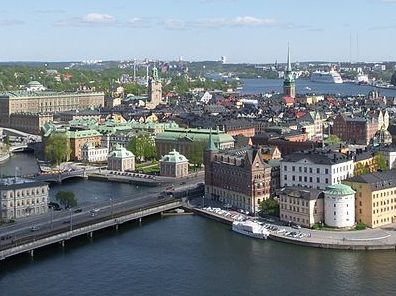Architecture of Stockholm, Sweden
Cover Photo by Perdo Szekely from flickr
Stockholm is the capital and largest city in Sweden. It has a unique layout when compared to most European Cities because it is dispersed on several different islands located between the Baltic Sea to the east and Lake Mälaren to the west. Stockholm has a long history spanning from the early middle ages to the modern era. It was an important port within the Hanseatic League and was the leading city within the Kingdom of Sweden and the Swedish Empire. This article will highlight some of the most important and culturally significant buildings within Stockholm, showing how the architecture of the city evolved from the early 12th century to the 21st century.

Photo by Holger.Ellgaard from Wikimedia Commons
Map of Stockholm
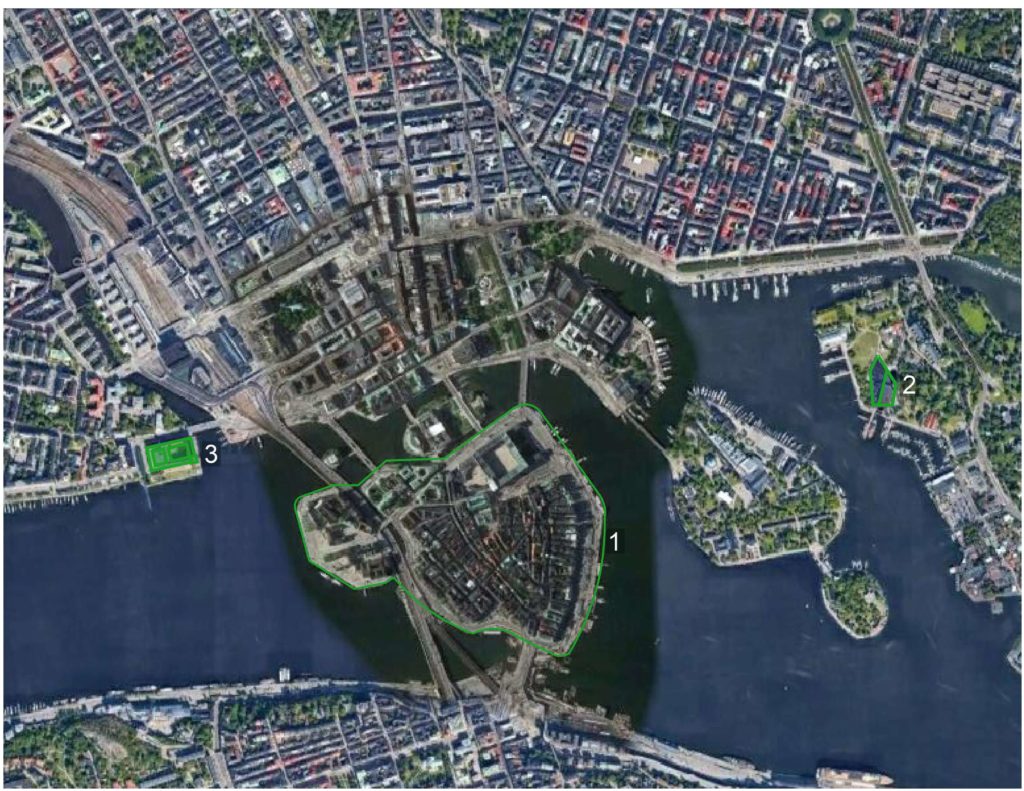
Map of Stockholm highlighting some of the city’s main attractions.
1. The Historic Center of Stockholm, the Gamla Stan 2. The Vasa Museum 3. Stockholm City Hall
Table of Contents
History of Stockholm
Unifying Elements in Stockholm Architecture
Influence from the Hanseatic League
Photo by Jorge Láscar from Wikimedia Commons
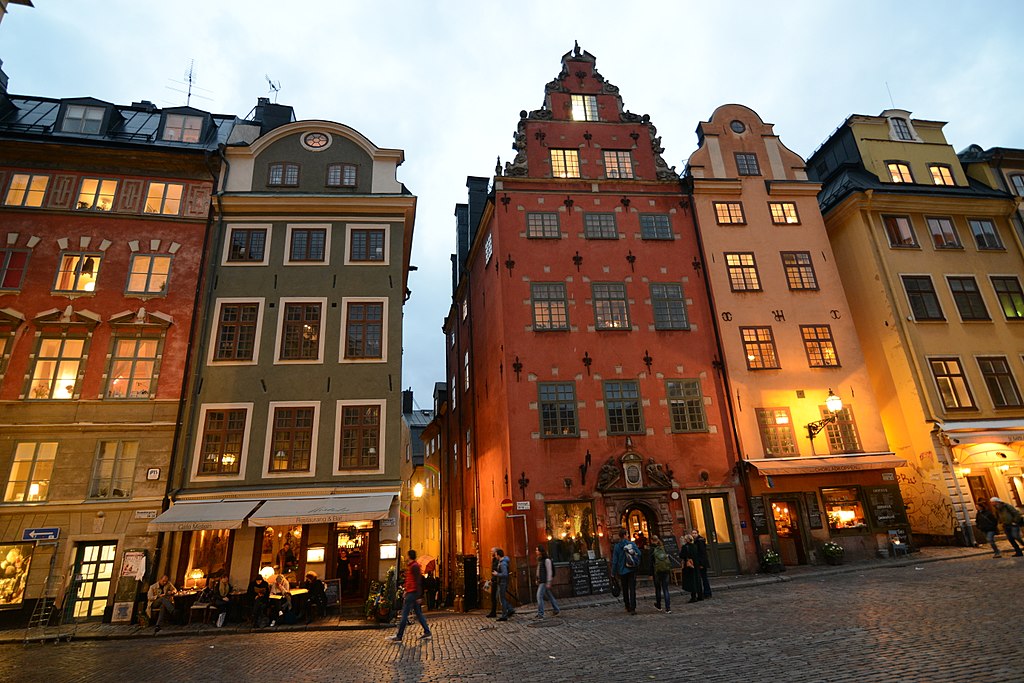
Stockholm was an important city within the Hanseatic League, a group of cities located around the Baltic Sea that heavily traded amongst one another. Other Hanseatic Cities such as Amsterdam, Hamburg, Lübeck, and Riga all contain similarly-styled buildings. The typical Hanseatic-Style house was designed specifically for trade and commerce. There was a ground floor that contained a shop, a few middle floors that contained most of the living quarters, and an attic space that was used for the storage of goods such as textiles, wool, and minerals. The facades of these buildings reflect this functional layout, and the image above shows a group of buildings in Stockholm’s Gamla Stan Neighborhood – here you can see the three layers of the buildings – the shop on the bottom, living area in the middle, and the storage attic at the top.
Scandinavian Vernacular Architecture
Photo by Herbert Shin from flickr
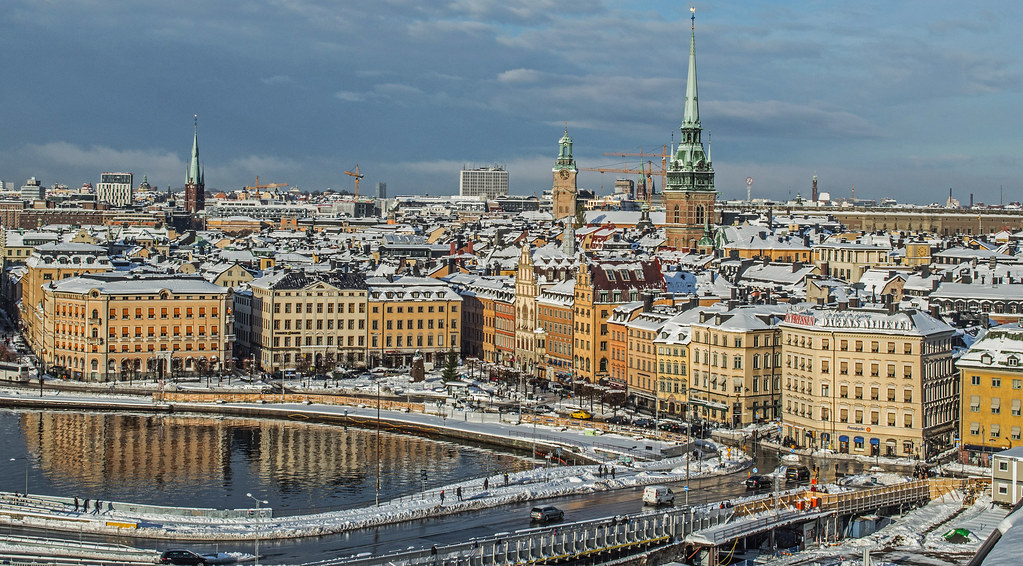
Nearly all of the historic buildings in Stockholm were designed for the harsh Scandinavian Climate. Ever since the days of the original Viking settlers of Scandinavia, buildings were meant to help the locals survive the long harsh winters. This is an element that unifies all of the traditional buildings found in nations like Sweden, Finland, Norway, and Denmark. Steeply pitched roofs to help with the heavy snowfall can be found on most buildings and tall thin windows which are good for letting in the low oblique angled sunlight are common throughout Stockholm.
Late 19th and early 20th Century Building Boom
Photo by Rasmus Andersson from flickr

Another unifying element in the architecture of Stockholm is the presence of buildings from the construction boom that coincided with the Industrial Revolution. This was the age of Revival Architecture and the Neo-Styles: Neoclassical, Neogothic, Neobaroque, and Neorenaissance. These styles replicated the buildings from Europe’s historic architectural heritage and they were all becoming common throughout the continent by the 19th century. Neoclassical architecture in particular was very popular in Sweden, as well as other Baltic States like Finland and Russia. In Stockholm, the neighborhoods of Östermalm and Södermalm were both heavily expanded at this point. The image above shows several grand buildings from this age, all located on the waterfront alongside the Strandvägen.
Medieval & Gothic Architecture in Stockholm
Stockholm’s central island was inhabited as far back as the 11th century CE. But it wasn’t known as Stockholm, until after the year 1252. This was when the Kingdom of Sweden was established, which grew into a powerful state up until the Plague came in the 1300s and killed nearly 35% of Scandinavia’s population. From then on Stockholm became a key city within the Hanseatic League. This was great for the city economically because it gained a strong presence in the trade networks of the Baltic Sea. But, it was bad for the Swedish culture and language which were in decline during the later middle ages. Large populations of German settlers immigrated into Sweden, and Stockholm gained a heavy german influence which still lasts to this day. To help protect Sweden from other Hanseatic Cities which were eager to take control of the nation’s trade, it pledged allegiance to the Kingdom of Denmark in 1397.

Map of Stockholm highlighting some of the greatest works of Gothic and Medieval Architecture in the city.
#5 shows the approximate outline of the Tre Kronor which was destroyed by a fire in 1679.
1. Gamla Stan
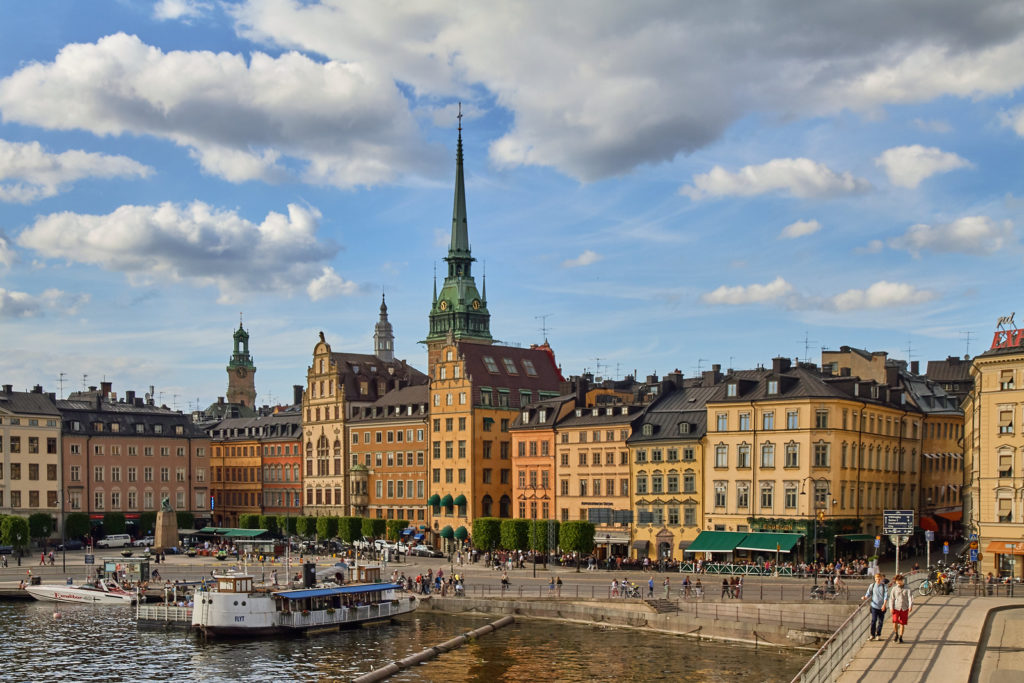
The Gamla Stan is the oldest part of Stockholm, and its located on a small island at the center of the Stockholm Archipelago. Many of the city’s most iconic buildings are located within this island, and the overall look of the neighborhood has remained relatively unchanged since the middle ages. The vast majority of the buildings follow the same mold and are heavily influenced by the architecture of other cities within the Hanseatic League. Many of the mercantile buildings on the island were built for trade, and they contained storerooms and workshops in addition to living space.

The cobblestone streets and the narrow alleyways are signature elements that give the Gamla Stan its distinct charm. Like many other historic centers in Europe, the Gamla Stan is protected by strict building codes, and there are few buildings built after WWII. Located on an island of less than 0.1 Sq Miles, the Gamla Stan has a very small footprint and yet it still contains several of Stockholm’s greatest works of architecture, such as the Royal Palace and the Nobel Prize Museum. Today it’s Stockholm’s most popular neighborhood for tourism, and buildings that once housed commercial storerooms now contain popular bars and restaurants.

Interested in other cities within Scandinavia? Check out our article on the Architecture of Copenhagen!
2. Stockholm Cathedral (interior)

Stockholm Cathedral, also known as Storkyrkan, was modified and renovated several times since it was completed in the year 1306. The exterior is one of the best examples of Baroque Architecture anywhere in Stockholm, but the interior still maintains its mostly Gothic appearance. The church was built with bricks rather than stone which was fairly common in buildings found throughout Stockholm. The design features all of the typical elements of Gothic Architecture, including pointed arches, rose windows, and rib vaulted ceilings. Stockholm Cathedral also houses one of the most famous works of art in the entire city, the statue of Saint George and the Dragon. The statue is unique because of the variety of materials used, including wood, metal, leather, and elk antlers. Although it depicts a religious figure, many believe that the statue was commissioned to symbolize the Swedes triumphing over their Danish rivals.
3. Stortorget

Stortorget is the main public square within the center of the Gamla Stan. The open area within the square has existed since the middle ages, where it was used as a market space and a gathering point during festivals and holidays. The facades of many historic buildings front the square, including several mercantile buildings from the 15th century. The Nobel Prize Museum Building, which was built in 1778, is also located in the square and can be seen on the right side of the image above. Today Stortorget is one of the most photographed locations within Stockholm, and the square is a popular hangout spot for both tourists and locals.
4. Riddarholmen Church
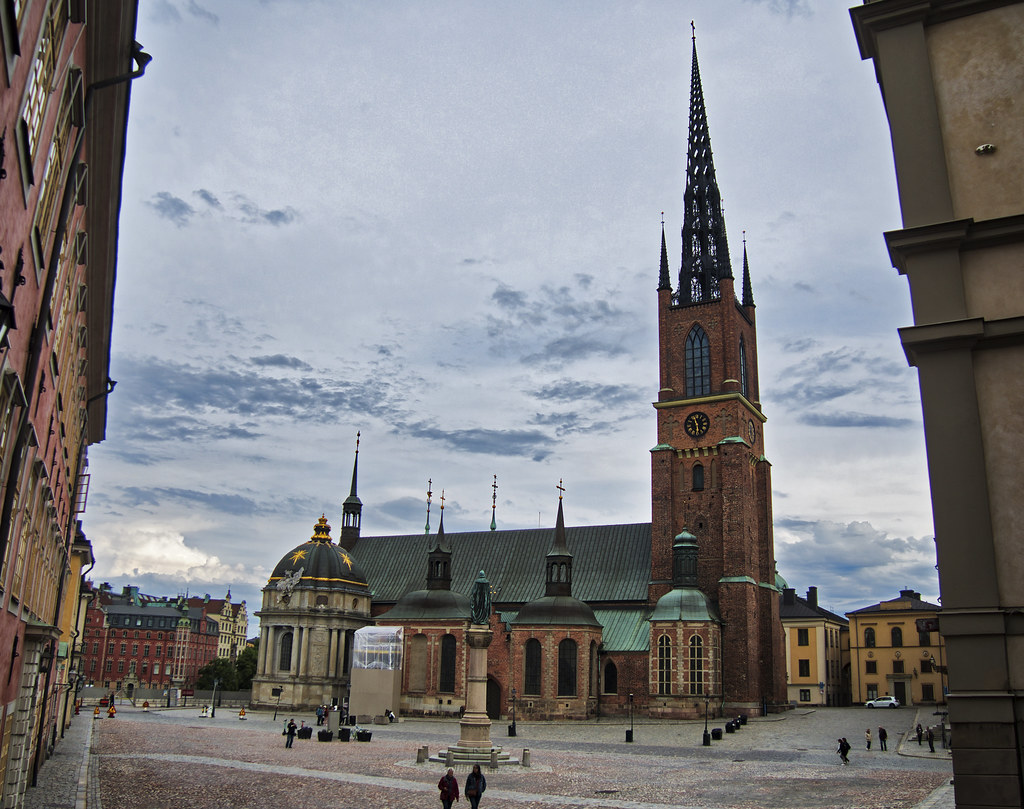
Riddarholmen Church, located on the island of Riddarholmen, is one of several important Gothic Style buildings located within Stockholm. The main portion of the church was built in the 13th century, when Gothic Architecture had spread to Stockholm from mainland Europe. Over time several side chapels in various other styles such as Renaissance and Baroque were added. The main spire is not original, however, because the former spire was destroyed by a lightning strike in 1835. The current cast-iron spire was added after this, and it gives the church a unique appearance unlike any other found within the city.
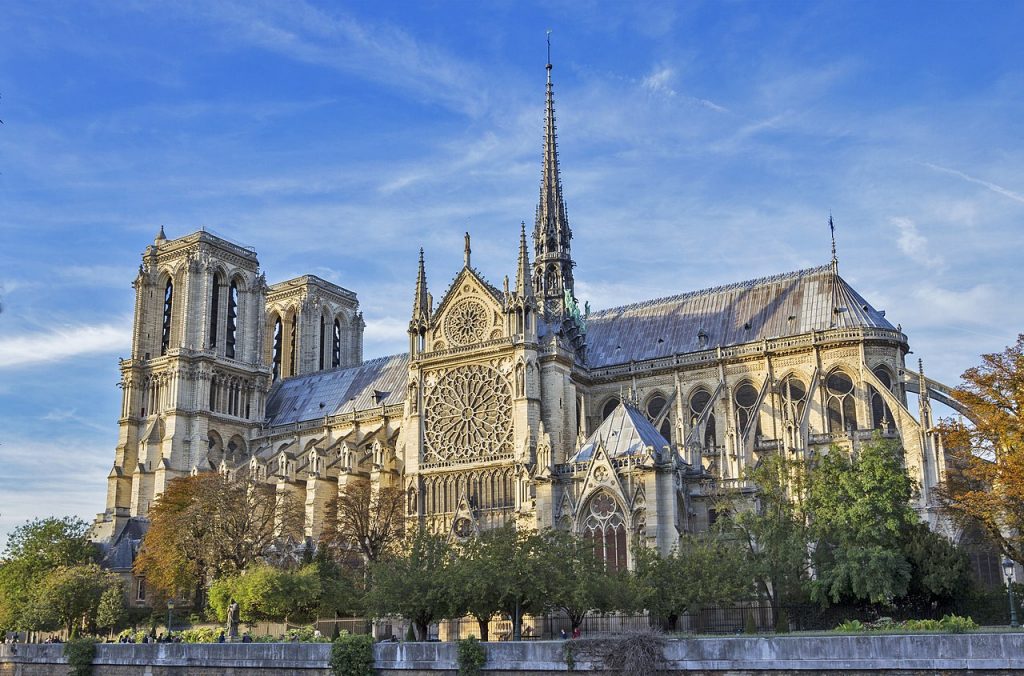
Interested in Gothic Architecture? Check out our Article, “Gothic Architecture: The Top 25 Examples” to learn more!
5. Tre Kronor (destroyed by fire)
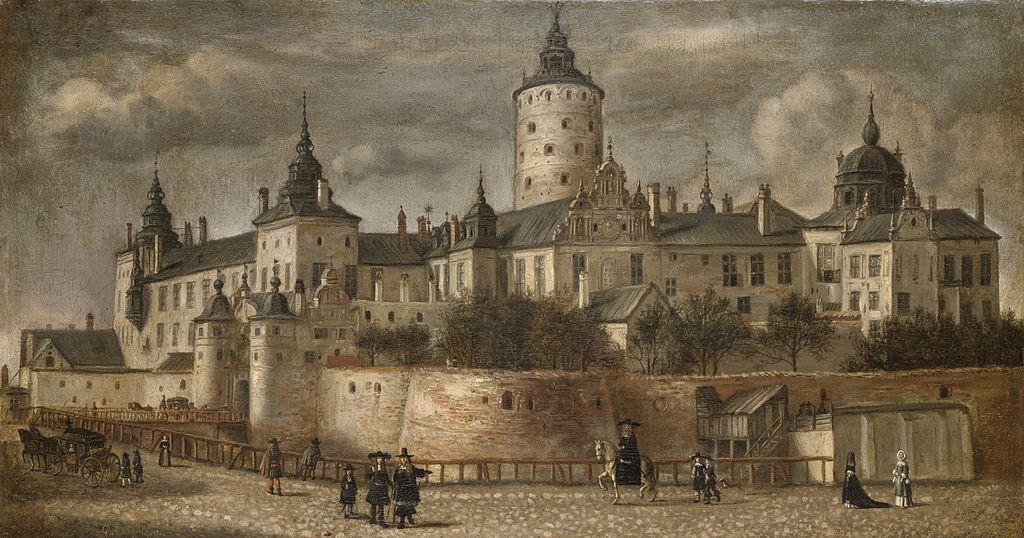
Although it doesn’t exist anymore, in its day the Tre Kronor was the largest and most important building within Stockholm. It was used as the city’s main defensive castle for hundreds of years, and it was converted into a royal residence in the 13th century. Normally this website only focuses on existing buildings that can still be visited – but the Tre Kronor is still worth mentioning due to its significance, and because the building’s foundation and the plot of land where it stood were completely converted to the Baroque Style Royal Palace of Stockholm in the 1700s. When a fire broke out in the year 1697, the Tre Kronor was destroyed and the treasures within the building, including all of Sweden’s National Archives, were lost.
6. Klara Church
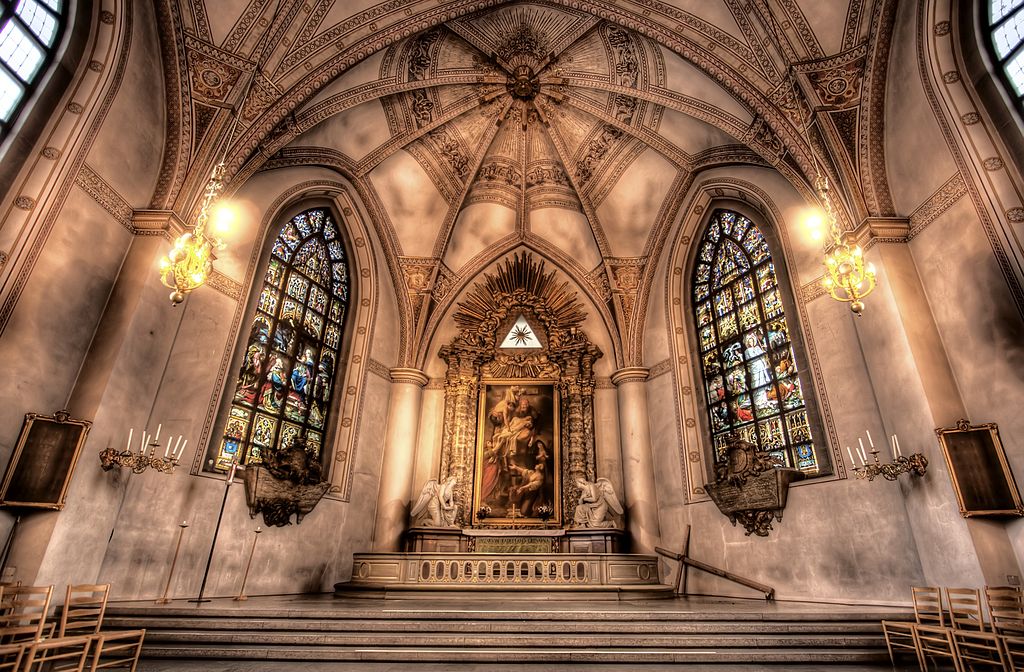
Klara Church is another Gothic Style building located in Stockholm. Sometimes referred to as the Church of Saint Clare, the Klara Church was originally built in the late 13th century. The original building stood until the 16th century, and it was eventually replaced by the current church in 1572. Although the second iteration of the church was built in a time when Renaissance Architecture was sweeping across Europe, the architects still utilized a typical Gothic Design, similar to the former building. The Klara Church is located within the Norrmalm Neighborhood of Stockholm, where it exists among many modern buildings.
Renaissance & Baroque Architecture in Stockholm
Stockholm and the rest of Sweden gained independence from the Kingdom of Denmark in 1523, after a long period of Danish Rule which began in 1397 after the inception of the Kalmar Union. The Danish had recently been reducing the freedoms of the Swedish Nobles and in 1520 the Danish King Christian II authorized the execution of over 50 Stockholm citizens, many of them town counselors or leaders of Noble Houses. This event, which became known as the Stockholm Bloodbath was a turning point in the union between Sweden and Denmark. Within a few years, Gustav Vasa would become the first independent King of Sweden in over a century.
Gustav Vasa and his successors would grow the size and influence of their kingdom, eventually creating a massive Swedish Empire. At its peak, the Empire of Sweden controlled a vast territory centered around the Baltic Sea, throughout the modern-day nations of Norway, Sweden, Finland, Germany, Latvia, and Estonia. The empire peaked in the late 1600s, and the Swedish Kings took over much of the trade routes that once belonged to other powers within the Hanseatic League. At this point, Baroque Architecture was Europe’s dominant style and therefore it’s no surprise that Stockholm contains many incredible Baroque Buildings.
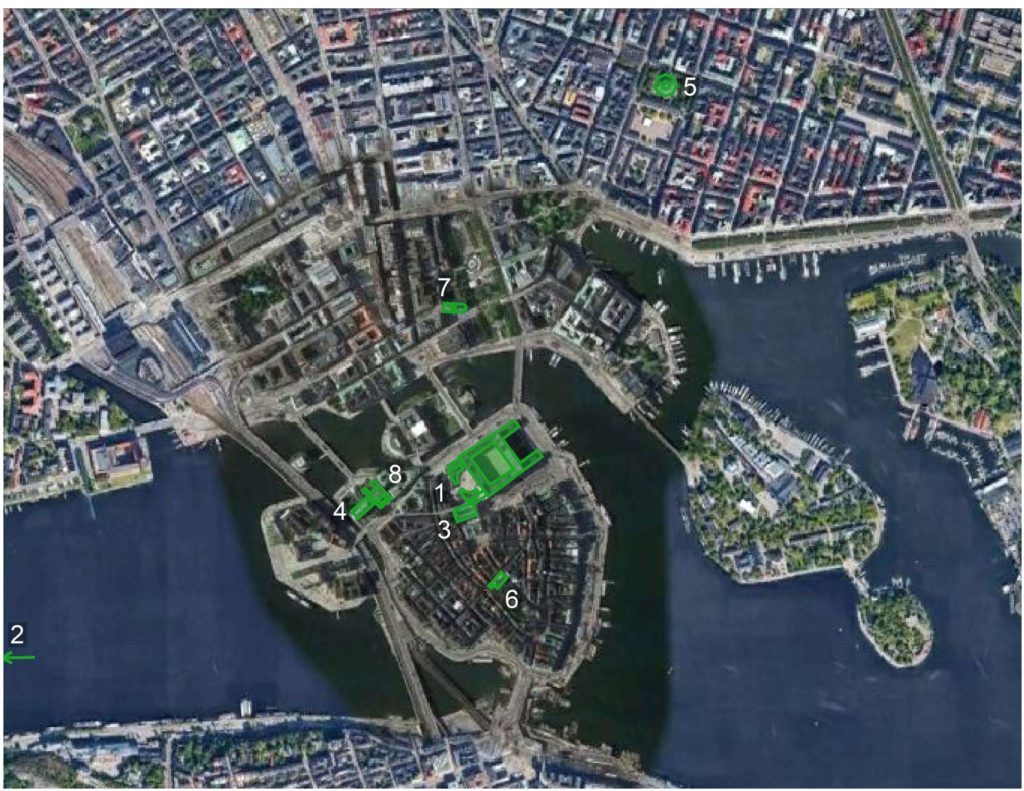
Map of Stockholm highlighting some of the greatest works of Renaissance and Baroque Architecture within the city.
Drottningholm Palace, #2 on the list below, is not depicted – it is located 7.5 miles (12 km) outside of the city center.
1. Stockholm Palace
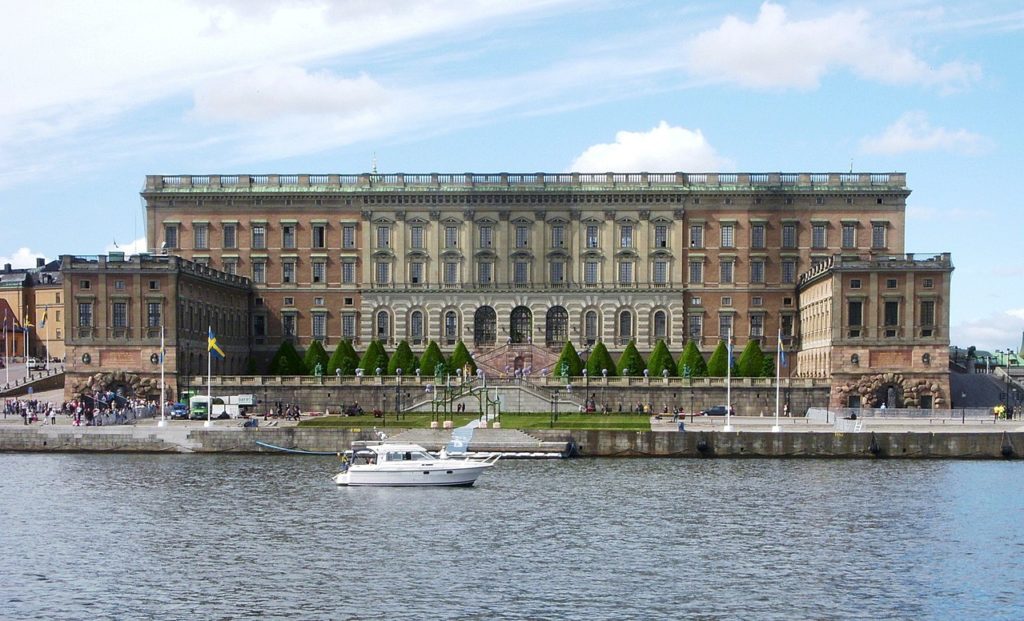
After a fire caused the accidental destruction of the Tre Kronor Castle in 1697, the Swedish Kings had their royal residence completely rebuilt in a new and modern style of architecture known as Baroque. The Baroque Style had emerged in Europe after the 30 Years’ War drastically changed the continent’s political landscape. Baroque Architecture is known for its intricate details and complicated geometry, and it is often found in palatial buildings from the 1700s. Construction of Stockholm Palace started in 1697 shortly after the fire and was completed in 1754. The palace has been one of several residences of the Swedish Royal Family ever since.

Today the palace is one of the most popular sites in all of Stockholm. Although nowadays the Swedish Royal Family primarily lives elsewhere, they still use the palace to host important parties and political events. The image above shows the western facade of the building, which faces a half-circle courtyard, known as the Parade Square. Today the square outside the palace is famous for the Changing of the Guard, a ceremony of the Royal Guard that takes place every day during the summer months in Stockholm.
2. Drottningholm Palace
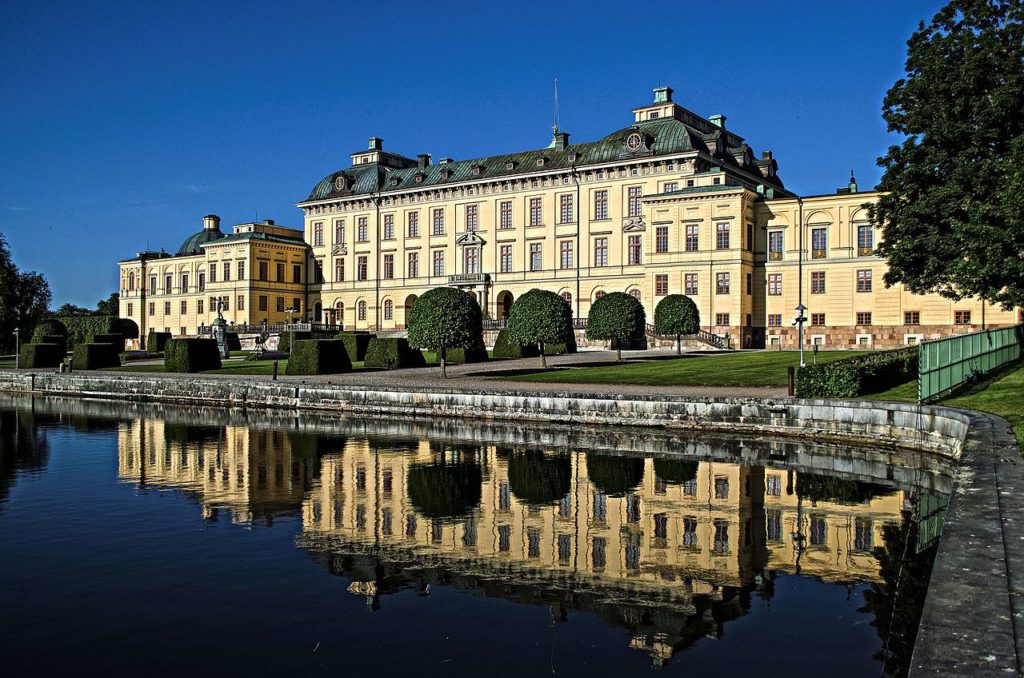
Drottningholm Palace is one of the most impressive palaces in all of Europe, on par with other well-known palaces such as the Château de Versailles in France and Buckingham Palace in England. Although it’s located about 7.5 miles (12 km) away from the city center of Stockholm, the palace is still within the city limits. It’s only about a 30 minute drive from the Gamla Stan, but many people prefer to visit the palace the way the Swedish Royal Family once did, by boat. Construction began on the palace in 1662, during the peak of the Baroque Age which lasted from the early 17th century until the mid 18th century.

Just like most Baroque Palaces in Europe, Drottningholm Palace also contains a vast Baroque Style Garden. The gardens also date from the late 1600s, and they are designed in a perfectly aligned axis with the palace itself. This linear garden plan was typical at this point in European History. All of the major European royal families were building bigger and grander palaces and gardens as a way to show their power and status. Today Drottningholm Palace is one of the most visited sites in all of Stockholm, and it is the only UNESCO-listed site located within the city limits.
3. Stockholm Cathedral (Exterior & Facade)

Stockholm Cathedral is the largest Baroque church in all of Stockholm, and it is the city’s most important religious building. Although the interior of the church has a predominantly Gothic appearance because it was built in the 13th century, the exterior of the church was completely redone in the Baroque Age. Also known as Storkyrkan, Stockholm Cathedral was seen as outdated and antiquated by the 18th century. So the Swedish Royals wanted to update the church to a style that was popular at the time. Work on the renovations occurred sporadically from 1736 until 1778 and the current exterior, front facade, and bell tower all date to this time period.
4. House of Nobility
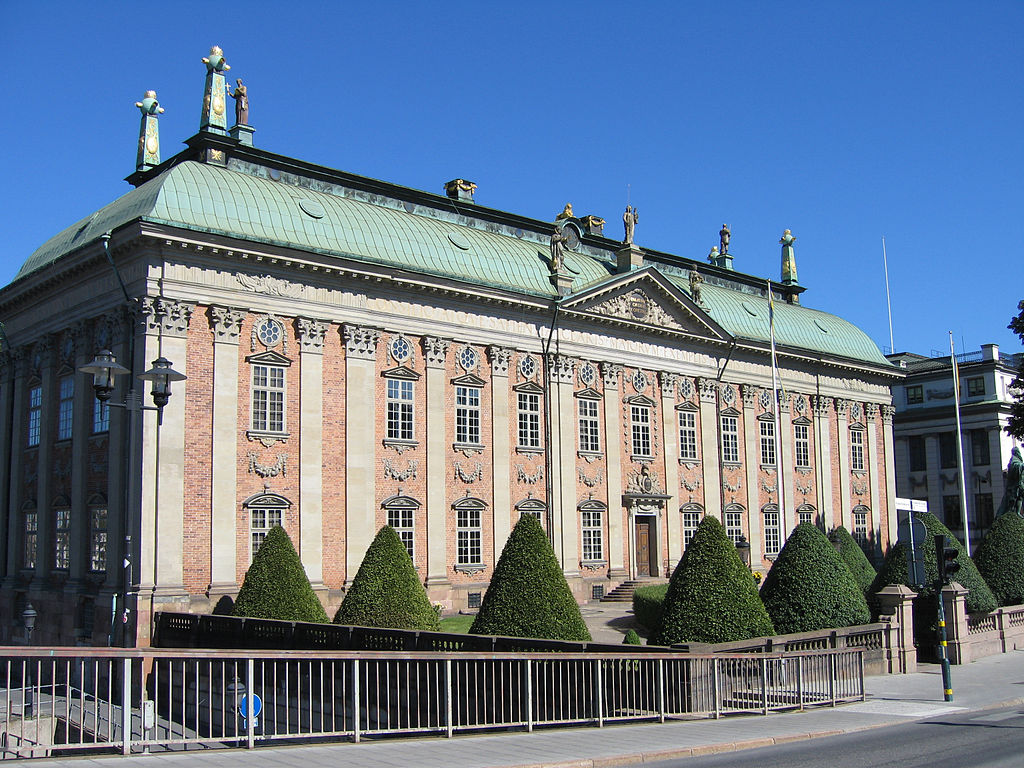
The House of Nobility is another great Baroque Building that was built within Stockholm. Although it’s a little older than most of the city’s other works of Baroque Architecture, it was still completed in the heart of the Baroque Age in the 1660s. The building has functioned in many different ways over the centuries, acting as a concert venue, an assembly space, and primarily as a storage space for important documents. Today the building is not open to the public and it is used to store important historical texts and city records.
5. Hedvig Eleonora Church
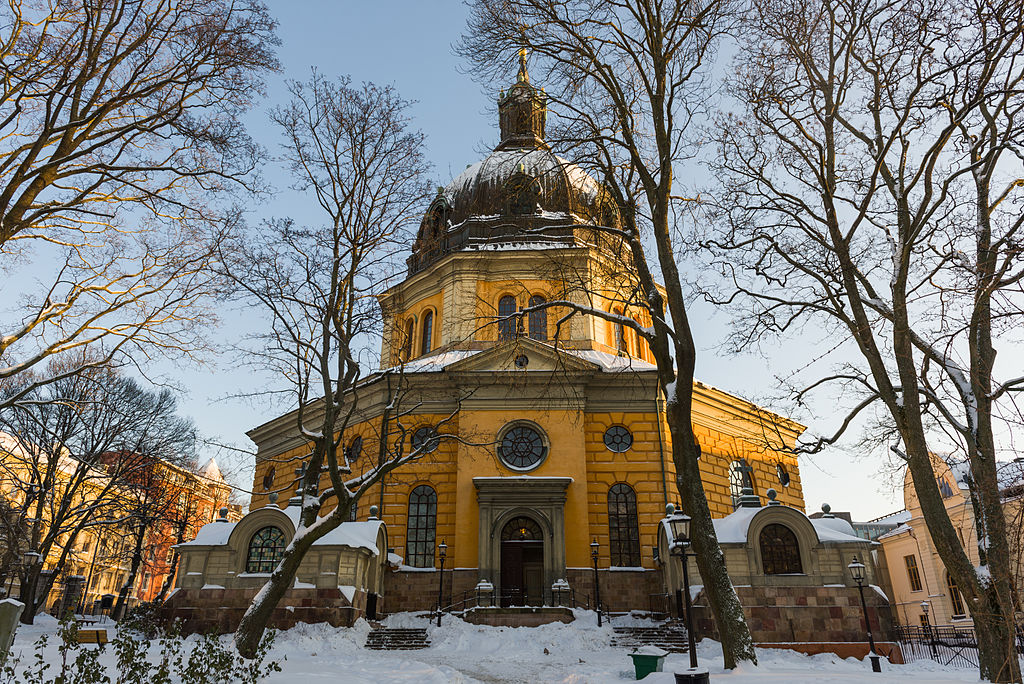
The Hedvig Eleonora Church was built in the 1730s, and it is one of the best baroque churches in all of Stockholm. Unlike Stockholm Cathedral and a few other churches on this list, the Hedvig Eleonora Church has a cohesive design and was built inside and out using Baroque Architecture. The church is symmetrical about all of its axis and has an octagonal plan with all of its sides being equal. From the exterior, you can see the eight-sided polygon, but from the interior, the central chapel is completely circular and topped with a perfectly circular dome.

Romanesque was Europe’s dominant architectural style from the 10th-11th century. Read our article, “Romanesque Architecture and the Top 15 Romanesque Buildings” to learn more!
6. German Church

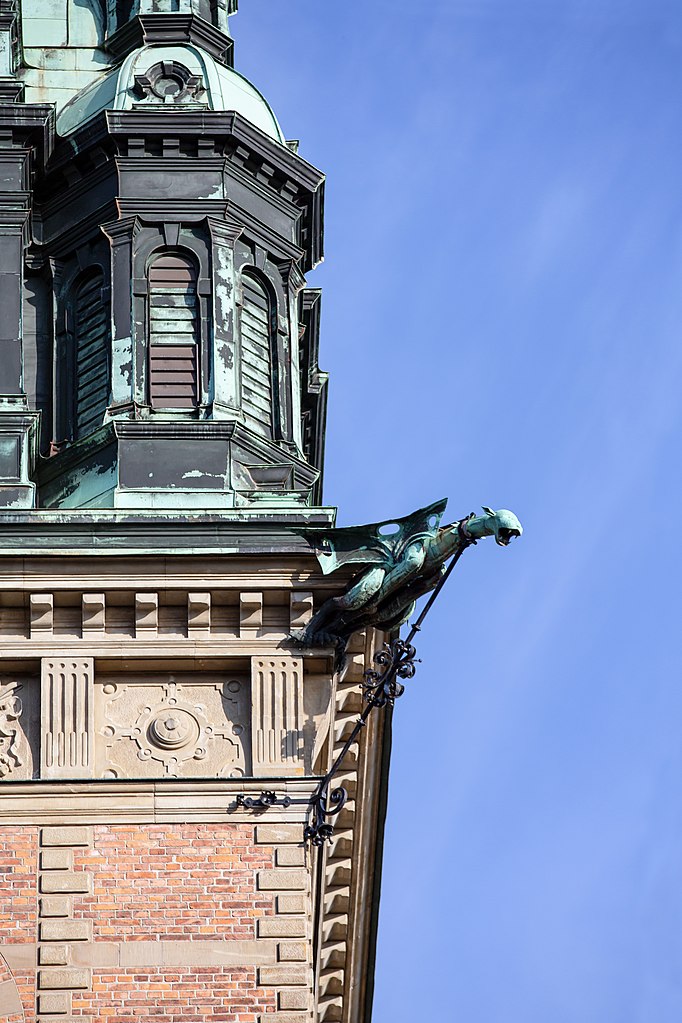
Stockholm’s German Church is one of the principal churches located within the Gamla Stan. It was built as a house of worship for the German Community living within Stockholm, hence the name. Stockholm was home to a sizable German population, thanks in large part to the city’s involvement in the Hanseatic League, which was a trading network that included many German cities such as Hamburg, Lübeck, Erfurt, Bremen, and Cologne. While the church was founded a few centuries prior, the main building that exists today was built in the mid 17th century. The bell tower of the church was rebuilt after a fire in the 19th century. Although it looks similar to the former tower, the rebuilt version incorporates many elements that were popular in the 1800s, such as the copper-clad lantern and the copper gargoyle-like downspouts.
7. Saint James’ Church
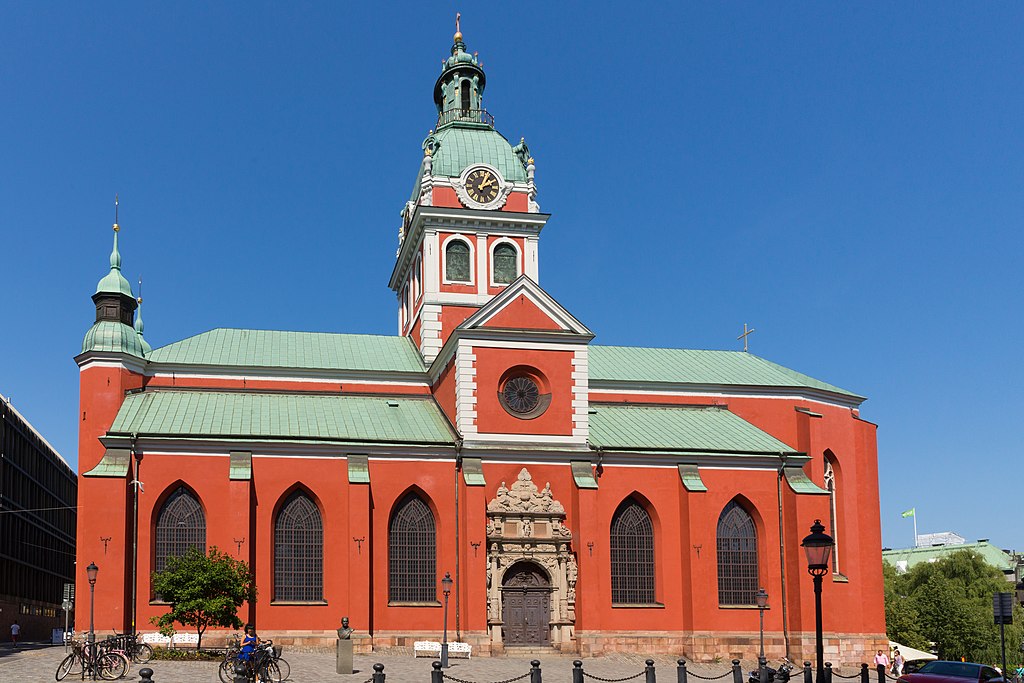
Saint James’ Church also referred to as Saint Jacobs’ Church, is located next to one of Stockholm’s most popular squares, the Kungsträdgården. Like so my other churches in Europe, it was built over the course of several centuries, starting in the 1500s and finishing in the 1800s. The multiple phases of construction are why you can see so many different design elements. The main windows of the church are built with pointed Gothic Style Arches. While the stone arch over the main entrance along with the central clock tower are built in the Baroque style.
8. Bonde Palace
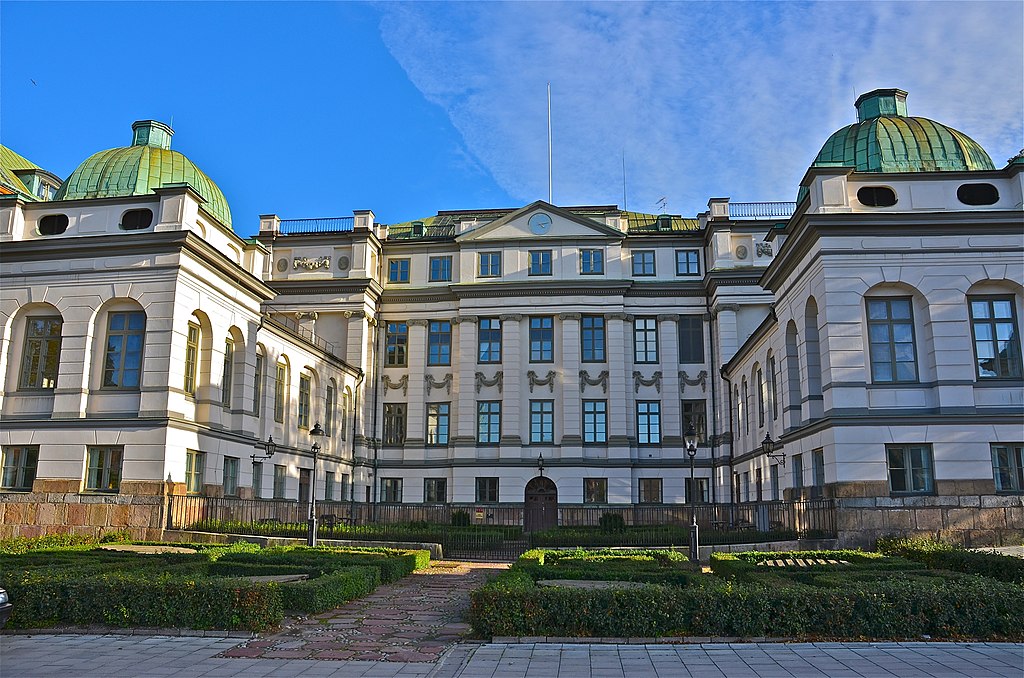
Bonde Palace is another Baroque Style residence within the city, although it is tiny when compared to the residences of the Swedish Royal Family such as Drottningholm Palace. It was built during the peak of the Swedish Empire, by a high-ranking imperial official. The palace is located on the outer edge of the Gamla Stan, right next to the House of Nobility. Today the building houses offices for the Supreme Court, and it has been retrofitted with many modern comforts such as electric lighting and an HVAC system. But great efforts were made to make sure the exterior of the building maintained its original appearance.
Neoclassical & Revival Architecture in Stockholm
As the power of the Swedish Empire dwindled in the 19th century, Sweden lost almost all of its Baltic territories. Eventually, the Kingdom of Sweden controlled an area largely corresponding to the nation’s modern borders. Although the Swedish Empire was a thing of the past, Stockholm was still an important trading port and it maintained a strong presence in the Baltic Sea. In the second half of the 19th century, Stockholm rapidly modernized. The city invested in its infrastructure and built many roads and bridges, as well as several major public and municipal buildings.
Like the rest of Europe, the Industrial Revolution had an incredible impact on Stockholm. Industries such as manufacturing, railroads, and newspapers, were contributing to an age of economic prosperity. The city also saw a huge building boom in the time leading up to the General Art and Industrial Exposition of Stockholm, which took place in 1897. Also known as the Stockholm World’s Fair, the event brought in visitors from all over Sweden, as well as the rest of the world.

Map of Stockholm highlighting some of the greatest examples of Neoclassical and Revival Architecture.
1. Strandvägen

Located along the waterfront on the edge of the Östermalm neighborhood, the Strandvägen is a wide 4-lane road that also houses one of Stockholm’s main tram lines. The origins of the road date to the 1870s, and the central row of trees, the waterfront promenade, and the adjacent buildings were all added in the following decades. All of the buildings in the surrounding neighborhood were completed for the Stockholm World’s Fair in 1897. Although not all of the buildings are Neoclassical there are several examples of this style located along the street, along with other buildings in other Revival Styles such as Neogothic and Neorenaissance.
2. Parliament House

The Swedish Parliament, also known as the Riksdag, has a long history that dates all the way back to the 15th century. Today, its members each work to govern the nation of Sweden and vote on important issues and legislation. The current Swedish Parliament House dates from the turn of the century, with construction lasting from 1897-1905. The building was built in the Neoclassical Style, which was common, especially for government buildings at this point in time. The governments of many nations in Scandinavia, the US, and UK all utilized this style as a way to connect their modern governments with the powerful governments of past civilizations such as the Greeks and the Romans.
3. Norrbro or North Bridge
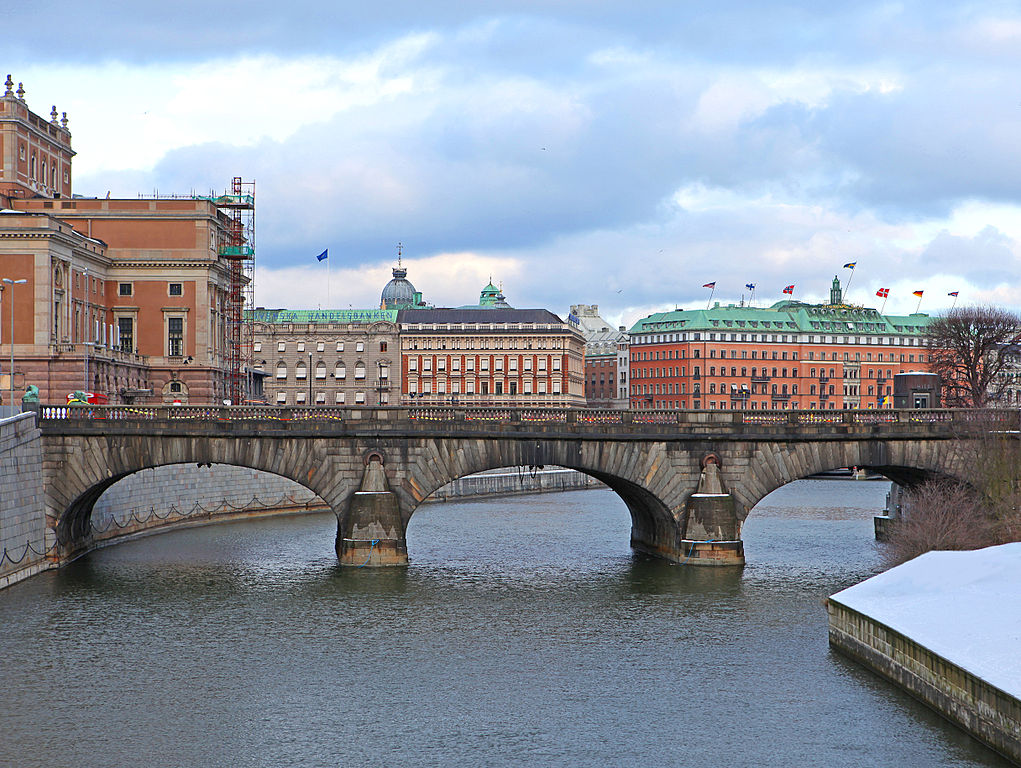
The Norrbro, which translates to North Bridge, is one of several historic bridges connecting the central islands of the Stockholm Archipelago. It was completed in 1803 and was one of the first stone bridges built within the city, replacing a much older wooden structure. The bridge connects the Norrmalm at its northern endpoint with the Gamla Stan at the southern endpoint. The bridge sits directly adjacent to the Royal Palace of Stockholm and the Stockholm Parliament House.
Like Architecture of Cities? Sign up for our mailing list to get updates on our latest articles and other information related to Architectural History.
4. Royal Swedish Opera House
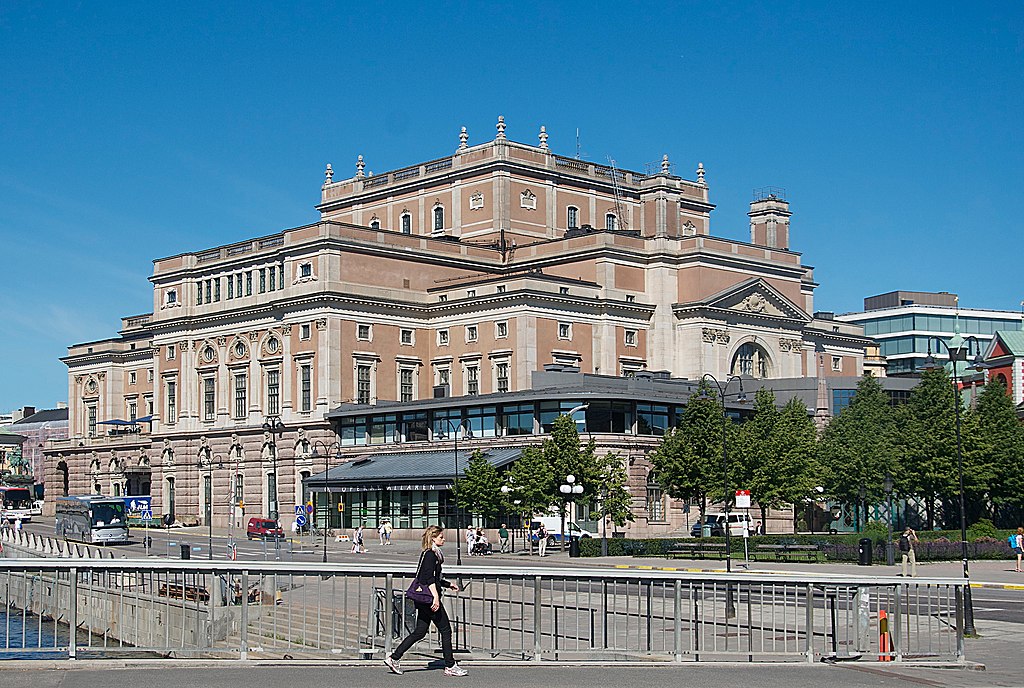
The Royal Swedish Opera House is a Neoclassical building located along the water edge, in the Norrmalm area of Stockholm. The current building incorporates several of the distinct features of Neoclassical Architecture, such as the use of pediments, molding, and columns from the classical orders. Originally a Baroque building from the 1770s housed the opera, but it was replaced by the current building in 1892. Today the Royal Swedish Opera House still does periodic performances, and the current King of Sweden, Carl XVI Gustaf, still has his own private seats which are used by the Royal Family.
5. Nordic Museum
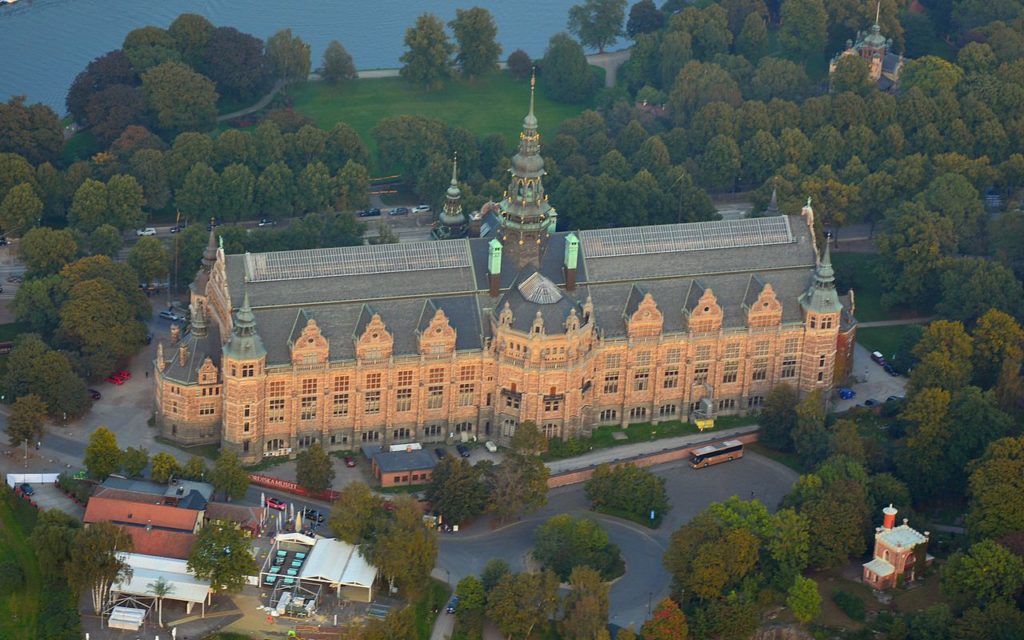
Located on the Island of Djurgärden, the Nordic Museum is one of Stockholm’s largest museums. The building was completed in 1907, after a lengthy and often problematic construction process. The original designs were for a much larger building, and city officials hoped that the building could be opened in time for the 1897 Stockholm World’s Fair. Despite dramatically shrinking the footprint, the building was completed way behind schedule. In spite of all this, the Nordic Museum is still an incredible work of turn-of-the-century architecture and it remains a popular museum destination in the modern city of Stockholm.
6. Nobel Prize Museum
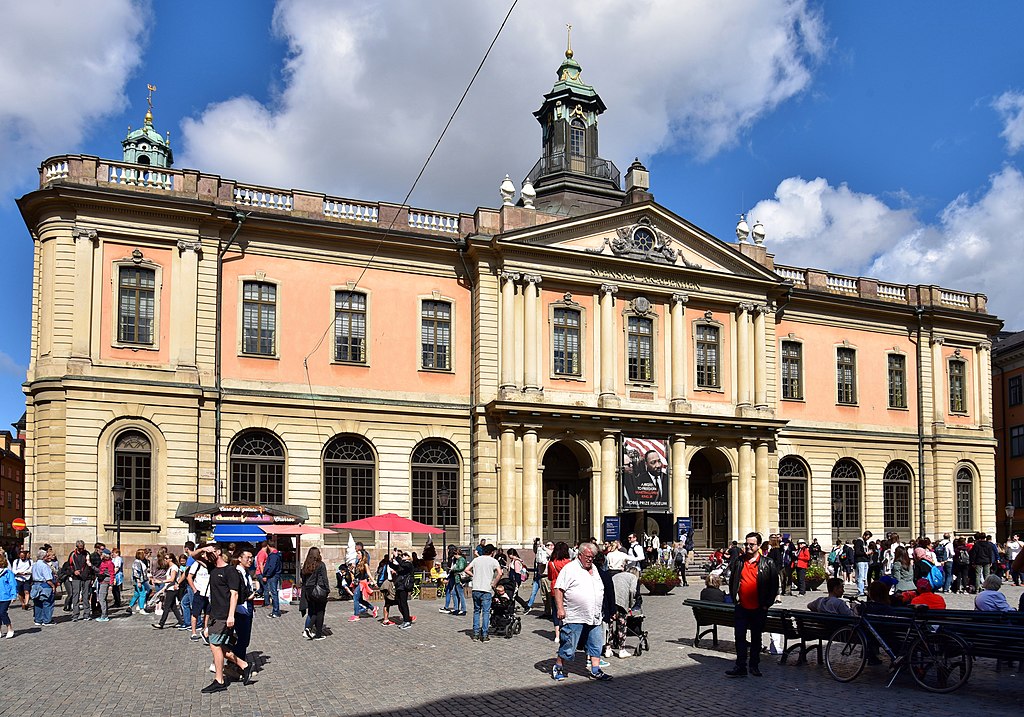
Although much smaller than other examples on this list, the Nobel Prize Museum might be the most iconic work of Neoclassical Architecture in all of Stockholm. This is thanks in large part to its prestigious location, within the main square of Stockholm’s Gamla Stan Neighborhood. It was completed in 1778 and designed by the same architect who built the nearby Norrbro Bridge. The building originally housed the Stockholm Stock Exchange, but since 2001 it has housed the Nobel Prize Museum.
7. Stockholm Central Station

The Stockholm Central Train Station was completed in 1871, and has served as the cities most iconic train station ever since. Although most of the modern Stockholm Metro System has since moved underground, the Central Train Station still connects Stockholm with other major cities in Sweden through traditional above-ground rail lines. Although the original building had a much more elaborate and decorative exterior, a lot of these decorations were costly to maintain, and a simplified facade was redone on the building in the mid 20th century.
8. Östermalm Market Hall
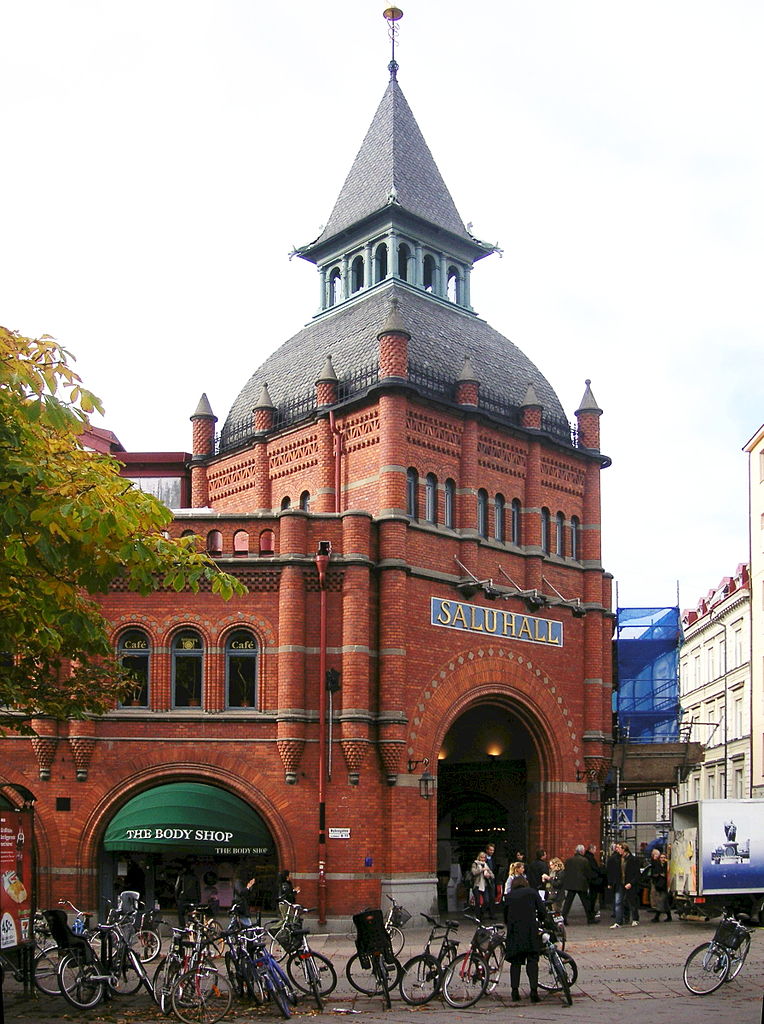
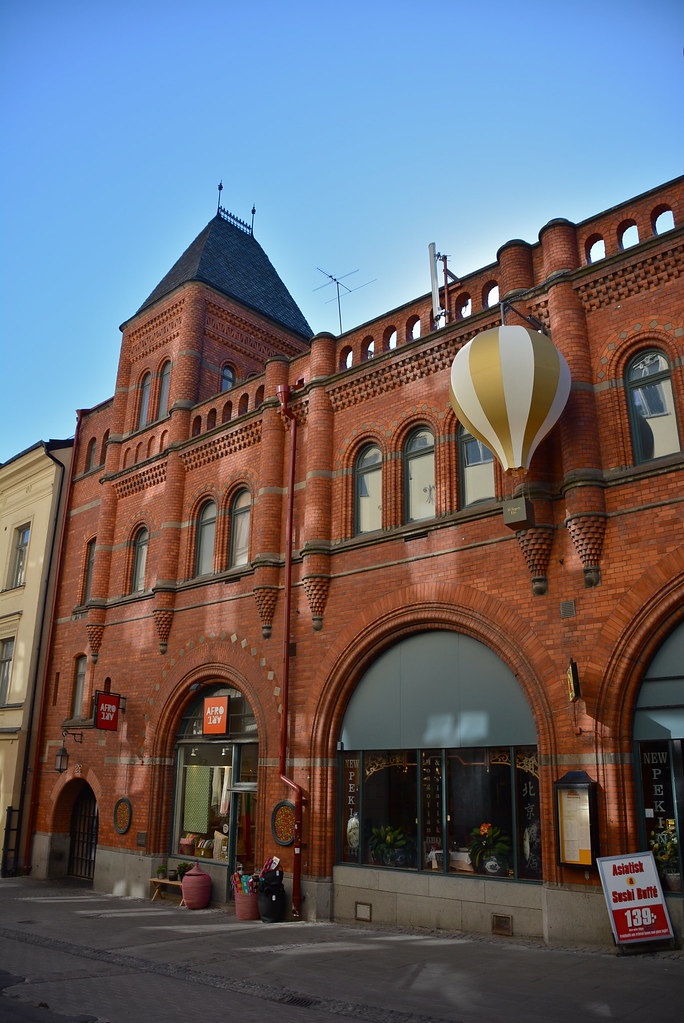
Throughout Europe, covered market halls were being built in major cities to house local shops and vendors. Up until the 19th century, most shopping for produce, baked goods, and other necessities was done outdoors and in the streets and squares. It wasn’t until the industrial revolution that covered market halls were built all across Europe. The Östermalm Market Hall is one of the greatest examples of these covered market halls within the city of Stockholm. This market also referred to in Swedish as the Östermalmstorg, opened in 1889 and still houses some local vendors to this day.
9. Norstedts Förlagsgrupp Building

The Norstedts Förlagsgrupp Building is one of those buildings that doesn’t fit within any singular architectural style. While most of the building borrows extensively from the Neoclassical Style, there are several elements from other forms of architecture. The roofline and its dormers resemble the roofs of many Gothic Style buildings from other Hanseatic cities, and the iconic spire of the building is completely unique and undefinable. It is possibly inspired by East Asian architecture with its distinct curvature, but it also has pinnacles that you find on many medieval European buildings.
10. Mariahissen

The Mariahissen is an iconic work of Neogothic or Gothic Revival Architecture in Stockholm. The building sits along the water in the Södermalm neighborhood. It is located within a niche blasted out from the adjacent cliff face. Originally in this location, an elevator brought pedestrians from the roadway below up to the top of the cliffs within Södermalm. The elevator which is now decommissioned was built as a way to better connect the rapidly expanding neighborhoods outside of Stockholm’s historic center.
Art Nouveau & National Romantic Architecture in Stockholm
After the turn of the century in the early 1900s, Stockholm continued to experience a building boom that would last until the global recession of the 1930s (taking a brief pause during WWI). This building boom went hand in hand with the economic prosperity that was felt in Europe and the Americas, particularly in the 1920s. Sweden chose to remain neutral during both WWI and WWII although some government actions were seen as contributing to the war effort. But overall Stockholm and the rest of Sweden remained largely untouched by these armed conflicts, unlike the neighboring Scandinavian nations of Norway and Finland.
During the first three decades of the 20th century, several major building styles were popularized. Art Nouveau Architecture, which was one of the most influential styles of this time period, was utilized in many privately owned buildings. Sweden also developed its own National Romantic Architectural Style, which was a building typology that borrowed elements from Sweden’s long-standing architectural heritage. The most important example of this style is the Stockholm City Hall, which combines elements from classical Italian Architecture, as well as features from Sweden’s traditional Scandinavian buildings.

Map of Stockholm highlighting some of the greatest examples of Art Nouveau and National Romantic Architecture.
1. Stockholm City Hall
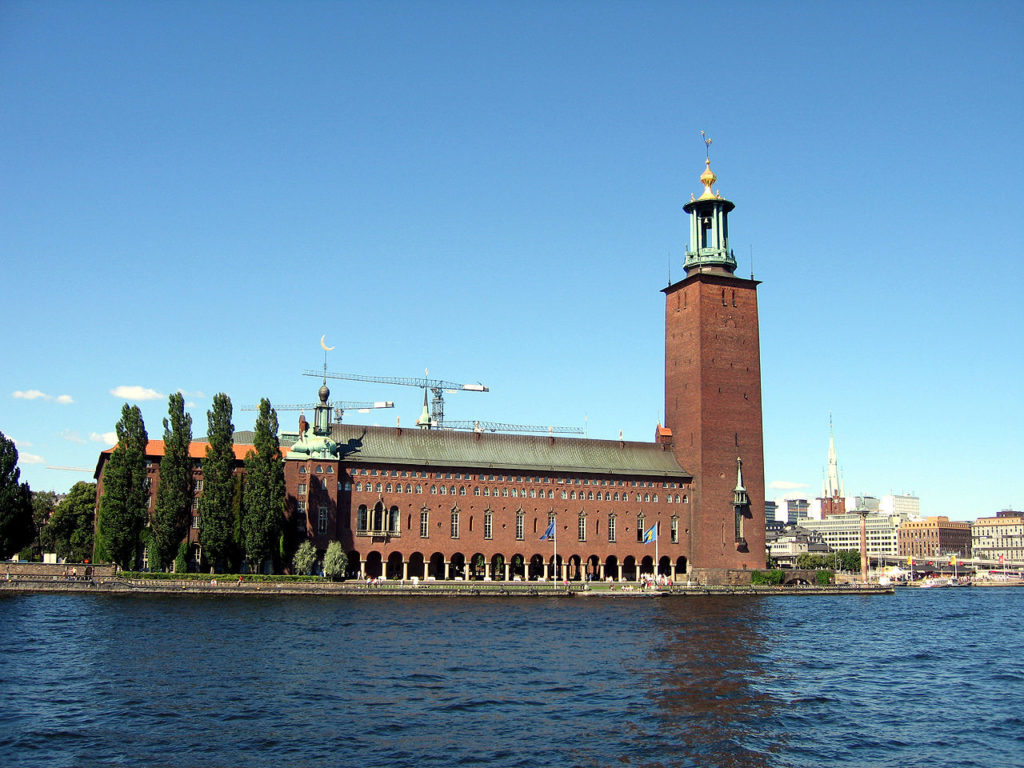
Much like in other parts of Scandinavia, city halls are some of the most impressive buildings in many Swedish cities. Stockholm, being the capital of Sweden, is no exception. Stockholm City Hall was built over the course of 12 years from 1911 to 1923. City officials chose to invest a great deal of money into the building, using lavish materials such as marble, copper, and gold mosaic tiles.

The Blue Hall in the image above is one of the building’s main spaces. Here you can see the eclectic nature of the building, which is a principal example of the National Romantic Style that was popularized in Scandinavia in the early 1900s. Stockholm’s City Hall borrows many elements from the architecture of the Republic of Venice, such as the Renaissance influenced balcony on the left side of the image above. The overall plan of the building also resembles many Venetian Gothic buildings, such as the Doge’s Palace in Venice, with a central courtyard surrounded by a covered collonade. But it’s the elements of traditional Swedish design that make Stockholm’s City Hall a National Romantic Style building. The red bricks that make up the majority of the building are found throughout Stockholm and Sweden, and there are dozens of sculptural elements such as fish and boats that allude to Sweden’s history as a maritime power on the Baltic Sea.
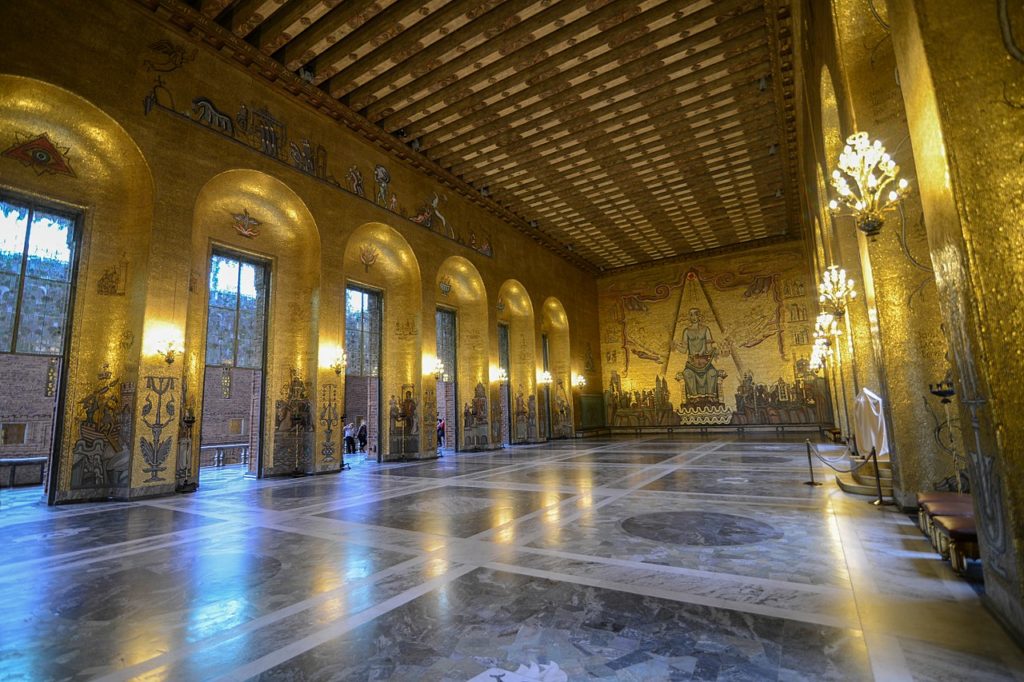
The Golden Hall the most ornately decorated room in the entire building. Thousands of mosaic tiles, many of them made from Gold Leaf cover the walls, and the mosaics depict many important elements of Swedish culture and industry. At the back of the room is a depiction known as the Lady of the Lake, a figure symbolizing Stockholm’s strategic position connecting the Baltic Sea with Lake Mälaren. Today Stockholm City Hall houses the city council along with a few other government agencies. It’s also famous for hosting the Nobel Prize Banquet each year. The building does welcome visitors and the exterior is one of Stockholm’s most popular hang-out spots, however, you can only see the inside through a guided tour.
2. Royal Dramatic Theater
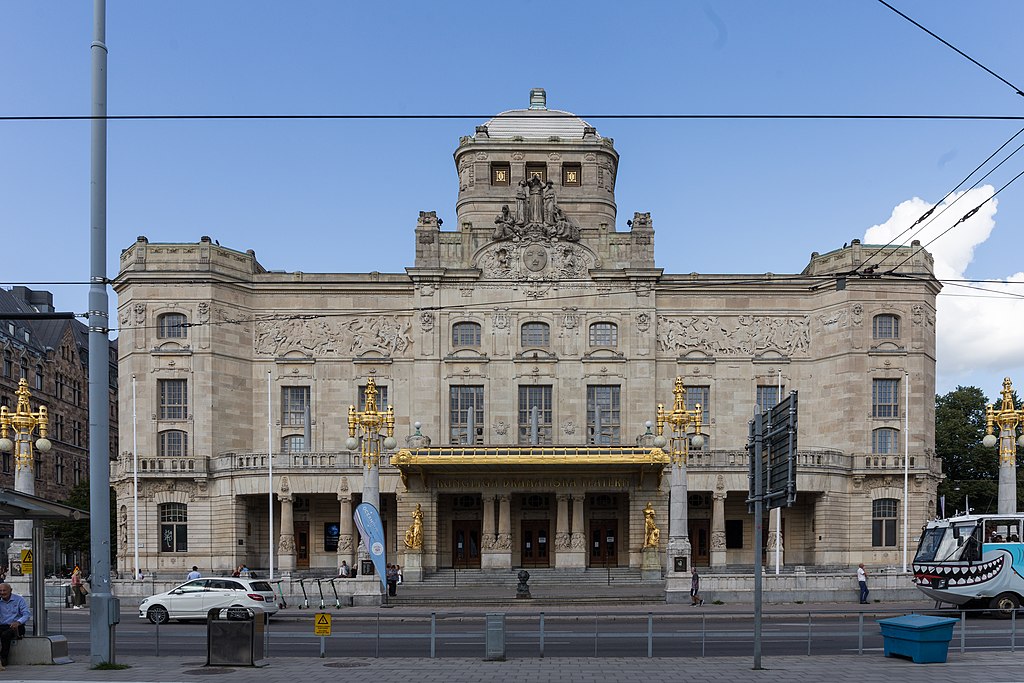
The Royal Dramatic Theater is another fantastic work of Art Nouveau Architecture located in Stockholm. The building opened in 1908 to house the Royal Dramatic Theater, which is a performing arts group that focuses on plays. The theater group originated in the 17th century, but it performed plays in various spaces in the city until this purpose-built theater was completed. The main facade features intricate stonework like many other Art Nouveau Buildings, and it illustrates the lavishness and grandeur found throughout architecture from this time period.
3. “Information Rosenbad” Building
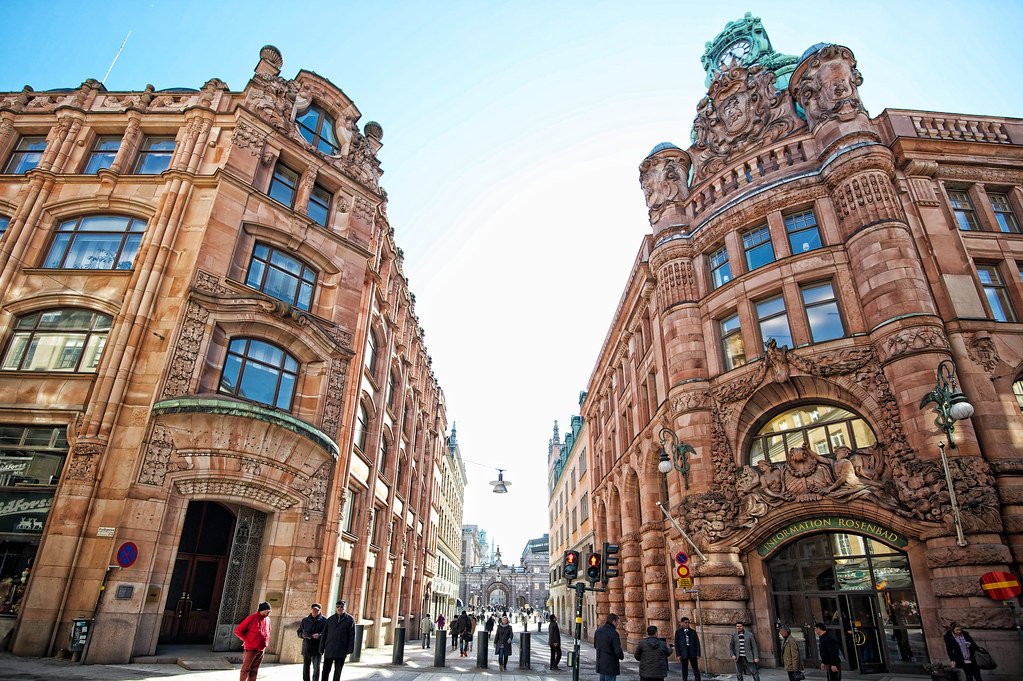
The Information Rosenbad Building (right side of the above image) is named for the green sign located above the main entrance. It is one of the greatest examples of Art Nouveau Architecture within Stockholm, and its ornate sculptural stonework is a classical feature found in most Art Nouveau Buildings. It’s located along one of the most popular retail and shopping locations in Stockholm, known as the Drottninggatan Pedestrian Mall. This lengthy street is lined with many shops and is home to many historic buildings. You can find the Information Rosenbad Building at the corner of the Drottninggatan and Fredsgatan.
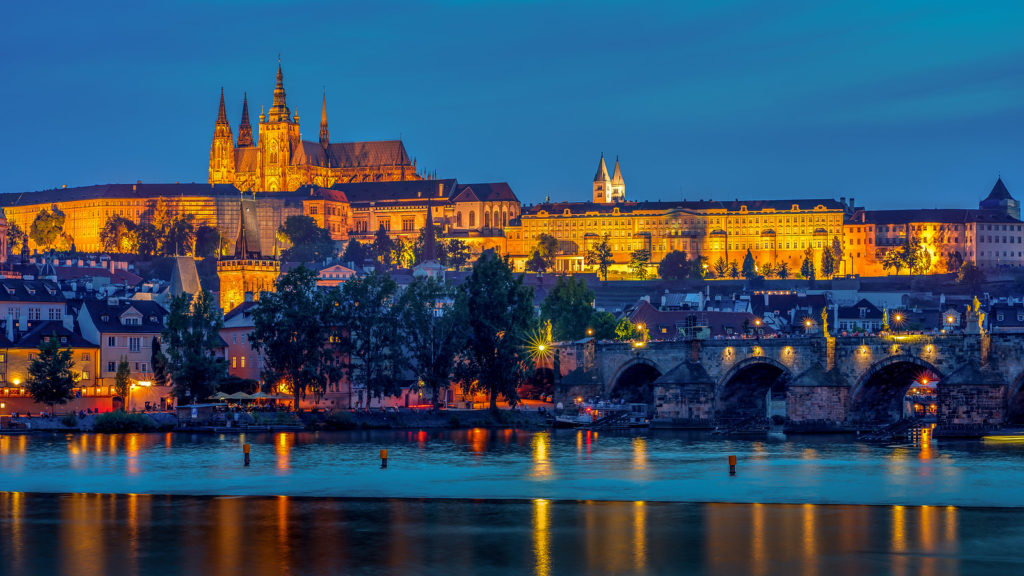
Interested in Art Nouveau Architecture? Prague has some of the best Art Nouveau Architecture found anywhere in Europe. Check out our article on the Architecture of Prague to learn more!
4. Diplomat Hotel & Esplanade Hotel

Located along the major roadway known as the Strandvägen, there is a pair of famous Art Nouveau buildings which today house the Diplomat Hotel and the Esplanade Hotel. Both hotels are popular with tourists thanks to their central location, on the waterfront of Nybroviken Bay. Both buildings were built as luxury residences in the early 1900s, but they were converted into hotels by the mid 20th century. Both buildings utilize a wide variety of arches, which is a key feature in Art Nouveau Architecture. You can see typical round arches, three-centered arches on the ground floor, as well as elliptical arches and elliptical windows.
5. Central Post Office Building
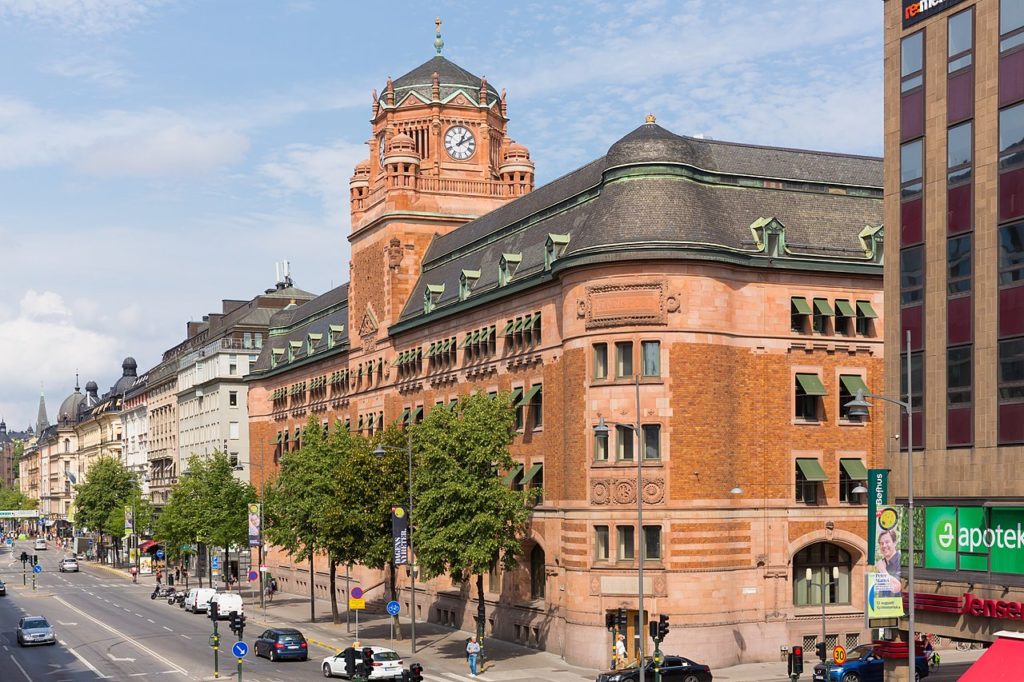
The Central Post office building of Stockholm was completed in the year 1903, and it served as the headquarters of the Swedish Post Office until the early 21st century. The building is made from a distinct red-colored sandstone that is found in Sweden. The design of the building is very fortress-like which was a popular concept for many government buildings such as treasuries and post offices. It was built to look strong and imposing, and many of the walls are several feet thick which adds to this effect Although you won’t find the Central Post office building on any of the lists of “sites to see in Stockholm” it’s still an incredible building that can easily be seen by pedestrians walking down one of Stockholms busiest streets, the Vasagatan.
Modern Architecture in Stockholm
Modern Stockholm is filled with countless examples of Contemporary Architecture, many of which are built in the distinct Scandinavian Minimalist Design style. Although the list below only highlights a few examples, Stockholm continues to build new and impressive buildings every year and it is a great city for fans of Modern Architecture. Stockholm is rapidly growing into one of Europe’s leading tech and service-based economies, and many international visitors come to the city to see both its historic and contemporary buildings.

Map of Stockholm highlighting some of the greatest works of Modern Architecture within the city.
#2 is the approximate location of T-Centralen Station, which is located underground along with the rest of Stockholm’s Metro.
1. Vasa Museum
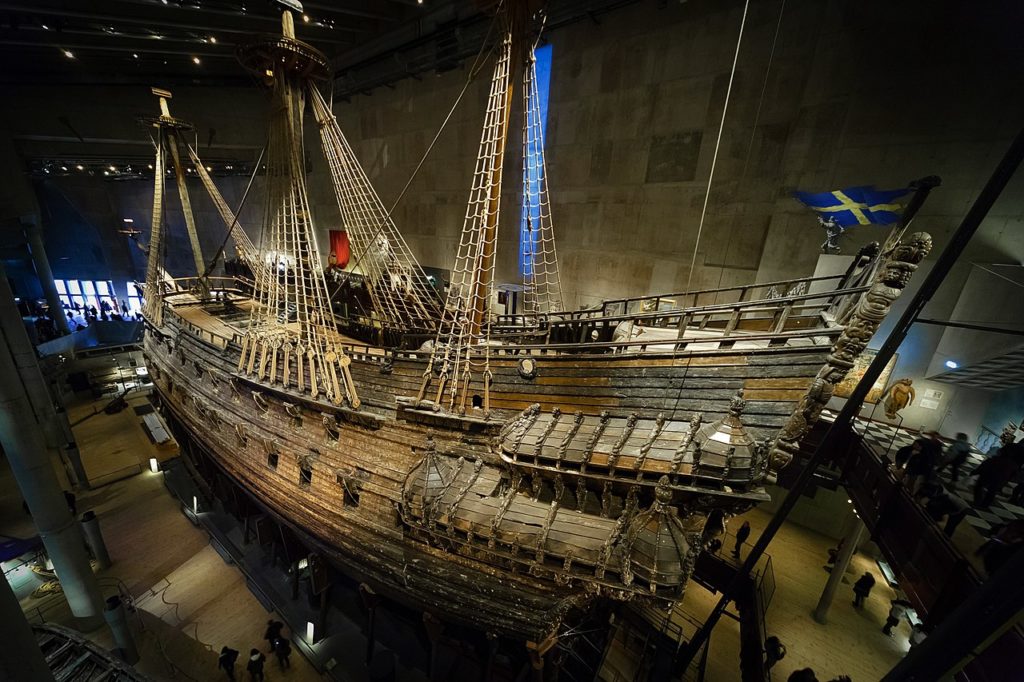
Stockholm’s most popular museum was completed in 1990, and it houses one of the greatest examples of 17th-century shipbuilding found anywhere in Europe, the Vasa. The Vasa Museum was purpose-built to house this ship, as well as a collection of artifacts found onboard. The main attraction is of course the Vasa itself, but the other exhibits provide a detailed glimpse into the life of the Swedish Sailors, many of whom died aboard the ship when it sank in 1628. The design of the building is unique because it was built to provide views of the ship from nearly every angle. The main material of the building is concrete, which is left exposed. The bare concrete paired with a state-of-the-art climate control system, help keep the temperature and humidity levels in the building at the ideal levels to help preserve the wood of the ship.

From the exterior, the building is designed to look like a ship with masts protruding from the roofline. These three masts are positioned in the same manner as they were on the original Vasa, but they are steel reproductions. The masts help identify the building as the Vasa Museum, and they’re extremely successful at doing so. You won’t see a giant sign that says “Vasa Musem” because the masts do the trick just fine, and they can be seen from all over the Stockholm Archipelago. The roofline of the building is also designed to resemble many of the old vernacular buildings found throughout Scandinavia.
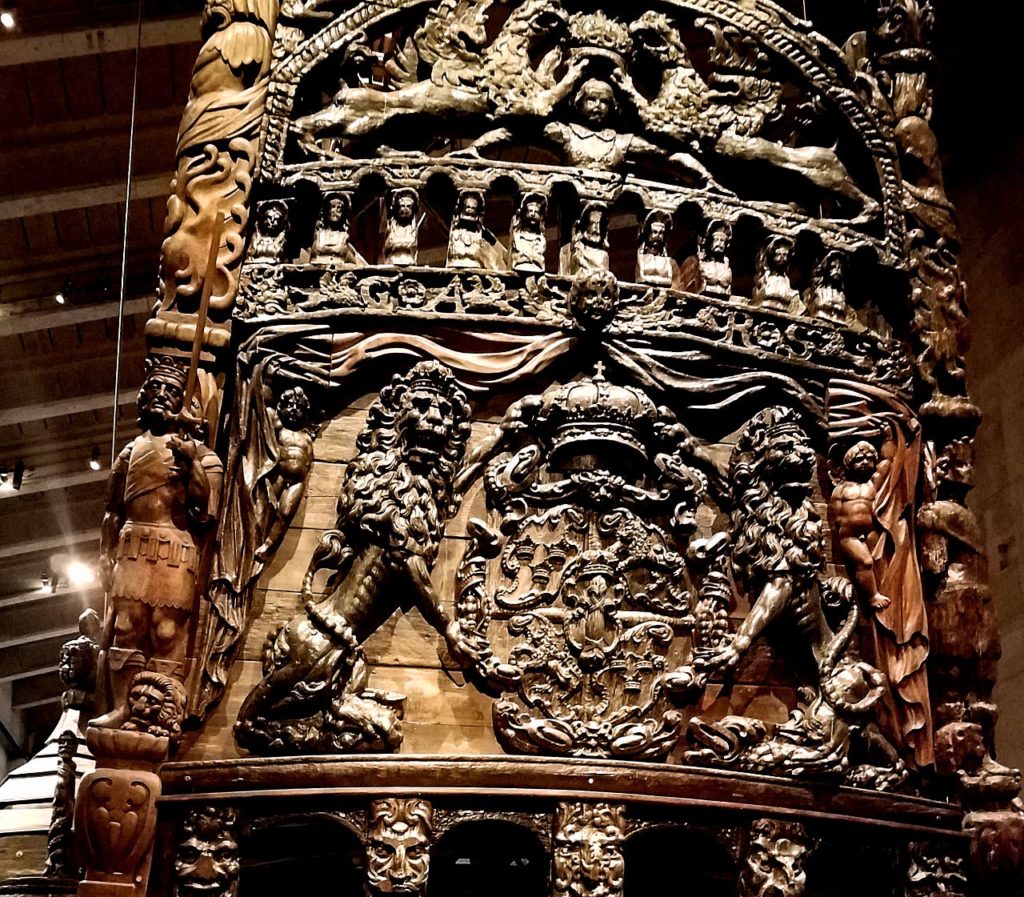
The Vasa itself is a great example of Maritime Architecture from the peak of the Swedish Empire. Here you can see the decorative woodwork at the stern of the ship. The Vasa sank on its maiden voyage in 1628. An extra row of cannons was added to the ship to increase its firepower, but this caused the vessel to be too topheavy. A sudden gust of wind caused it to capsize and eventually sink in shallow waters just a few miles from Stockholm. Although a huge failure and an embarrassment for the Swedish Government in the 17th Century, the ship remained preserved in the cold ocean waters, and it was salvaged by the modern Swedish Government in the 1960s.
2. Stockholm Metro
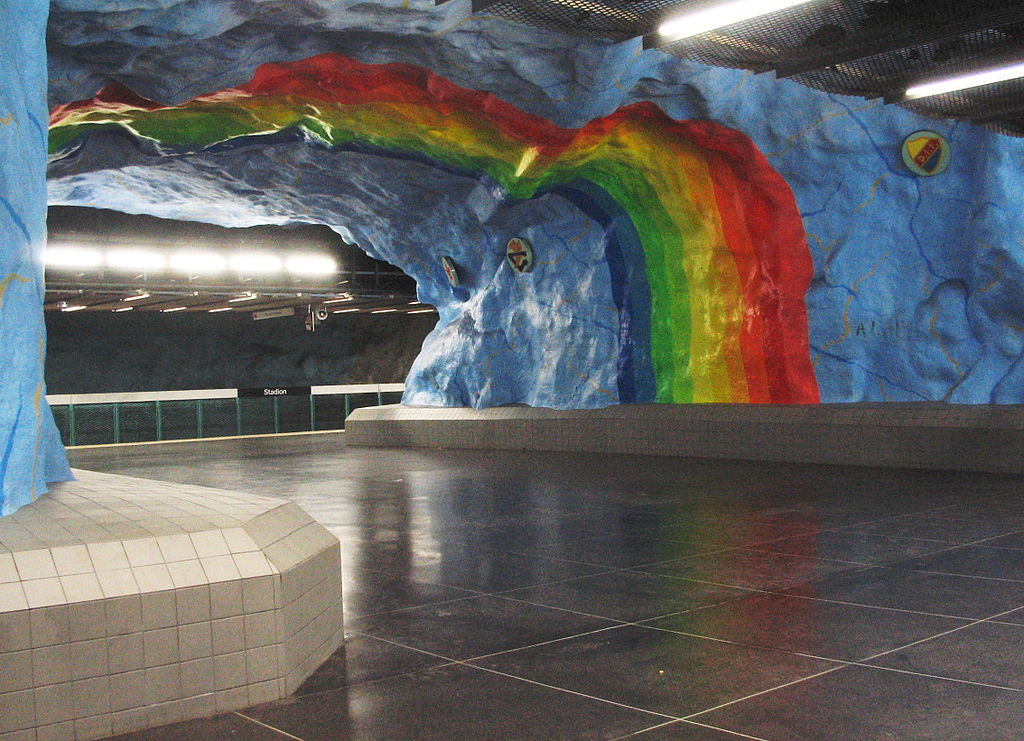
The Stockholm Metro began service in 1950 and since then it has been known as one of the most beautiful metro systems in the entire world. The builders chose to leave the bare rock exposed throughout many of the stations, rather than creating actual walls and ceilings like in many other metros. This decision was not only economical, but it allowed for the city to hire dozens of prominent artists to decorate the interior of the train lines and train stations. The image above is of the Stadion stop, along the red line.
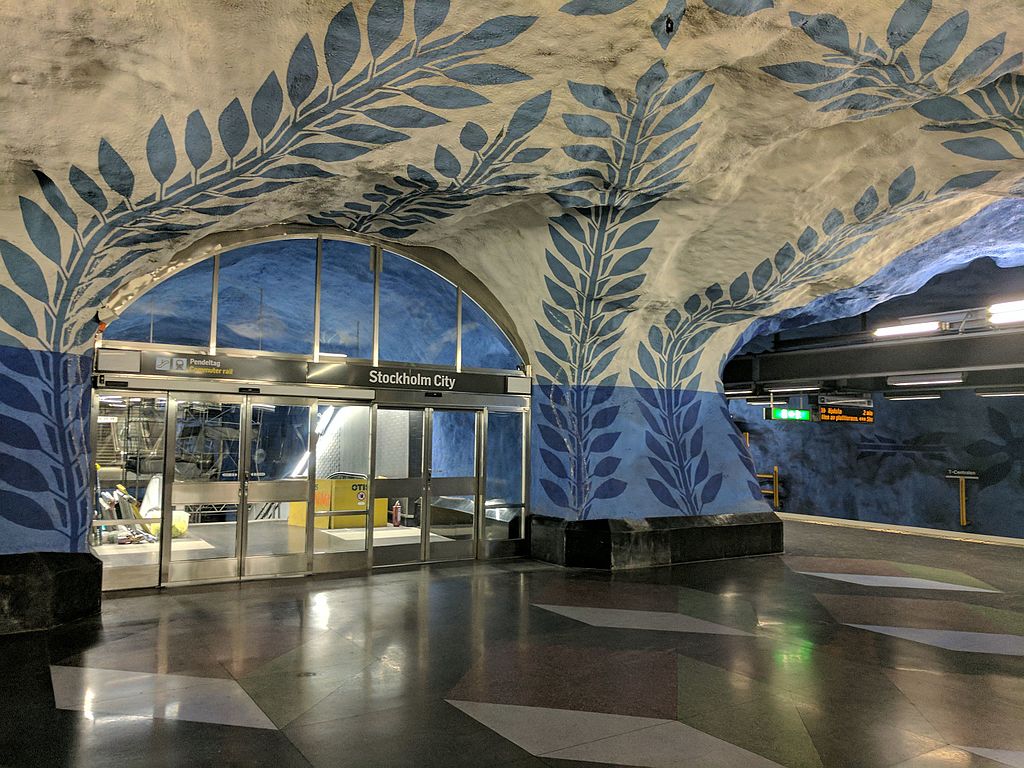
The raw rock-cut architecture within the stations is a similar concept to many of the traditional Rock-Cut Buildings throughout the world, but here there is a modern and innovative twist. Many tourists take the metro just to catch a glimpse of these elaborately decorated tunnels, such as the ones in Stockholms main subway station, T-centralen(depicted above). For a full list of some of the most impressive train stations, you can check out this article.
3. Hötorget Buildings & Sergels Torg

Stockholm’s main commercial square is Sergels Torg, and its located within the Norrmalm neighborhood. The square is a great example of modern urban planning. It’s completely surrounded by contemporary buildings that utilize modern materials like glass, concrete, and steel. This area of Stockholm is a nice contrast to the traditional historic architecture of the Gamla Stan. At the center of the square, there is a large tower-like sculpture that is a modern twist on the traditional obelisk. You can also see the Hötorget Buildings on the left side of the image above, which are five identical high-rise buildings that were built from 1952-1966. The buildings are a great example of the Modernist movement that was popularized in Europe and the Americas in the decades after WWII.
4. Parliament House (addition)
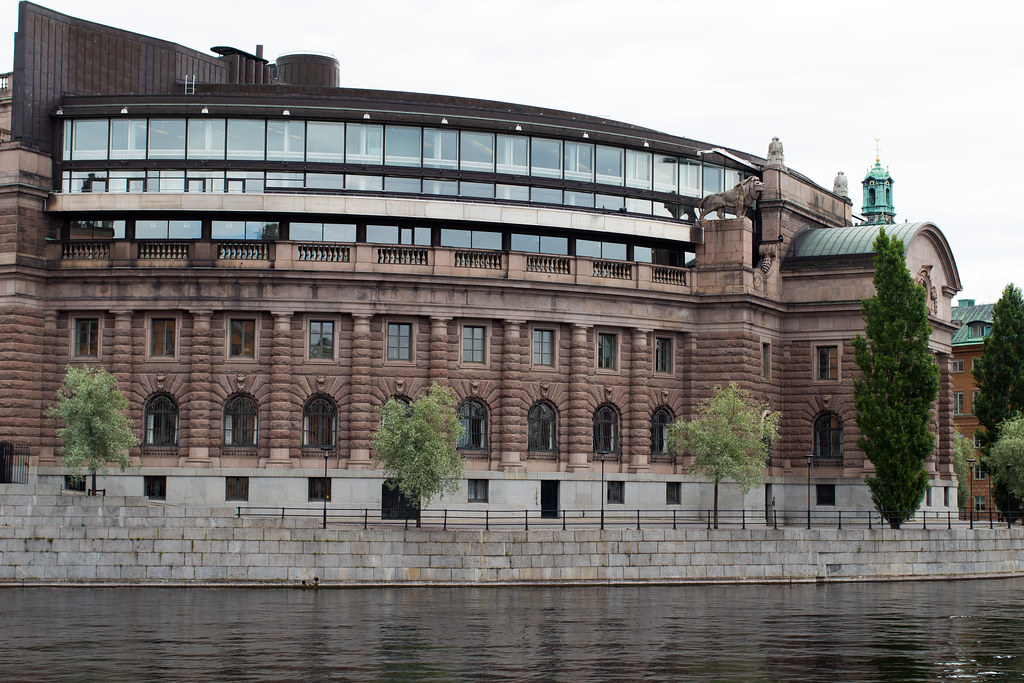
In the 1970s a massive renovation and addition project was underway to modernize the chambers of Sweden’s Riksdag. The Riksdag, which is the Parliament for the nation of Sweden, has been housed in the adjacent Parliament House since the 19th century. This renovation created some new assembly chambers, as well as lots of space for offices. The top floors of the building feature a glass curtain wall that blends seamlessly with the Neoclassical building below. The entire Swedish Parliament Complex is located at the edge of the Gamla Stan, and is a great example of the old-meets-new architecture that can be found throughout many modern European cities.
Neighborhoods of Stockholm
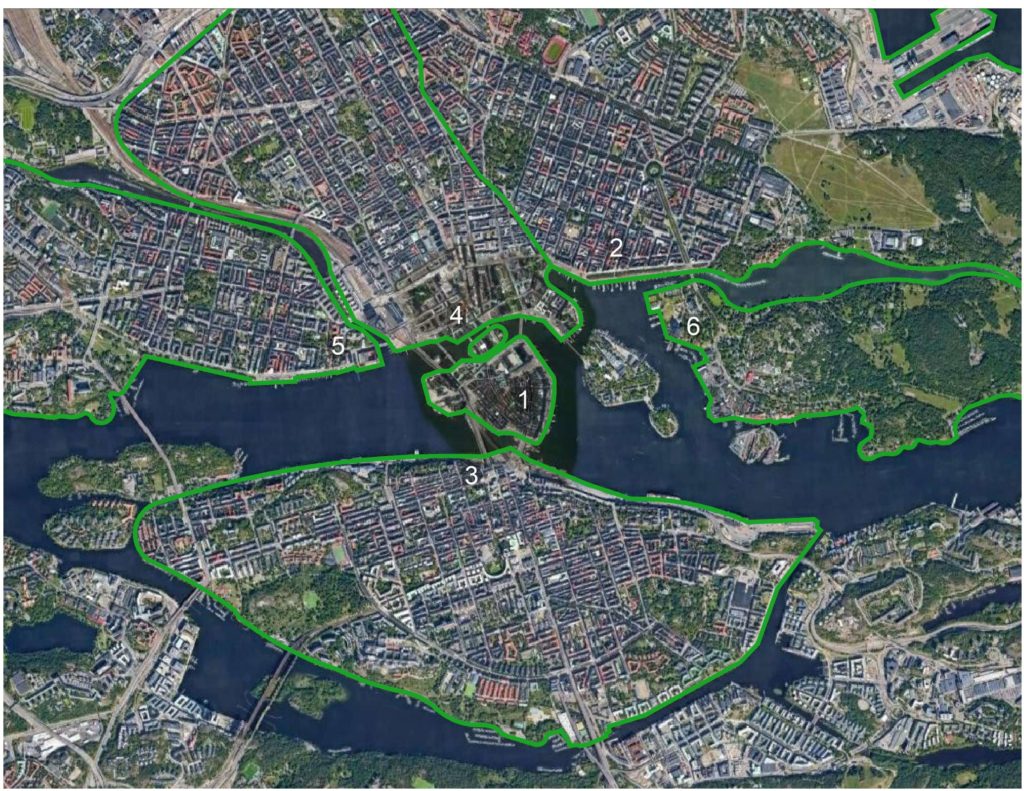
Map of Stockholm Showing the extents of the various neighborhoods within the city
.
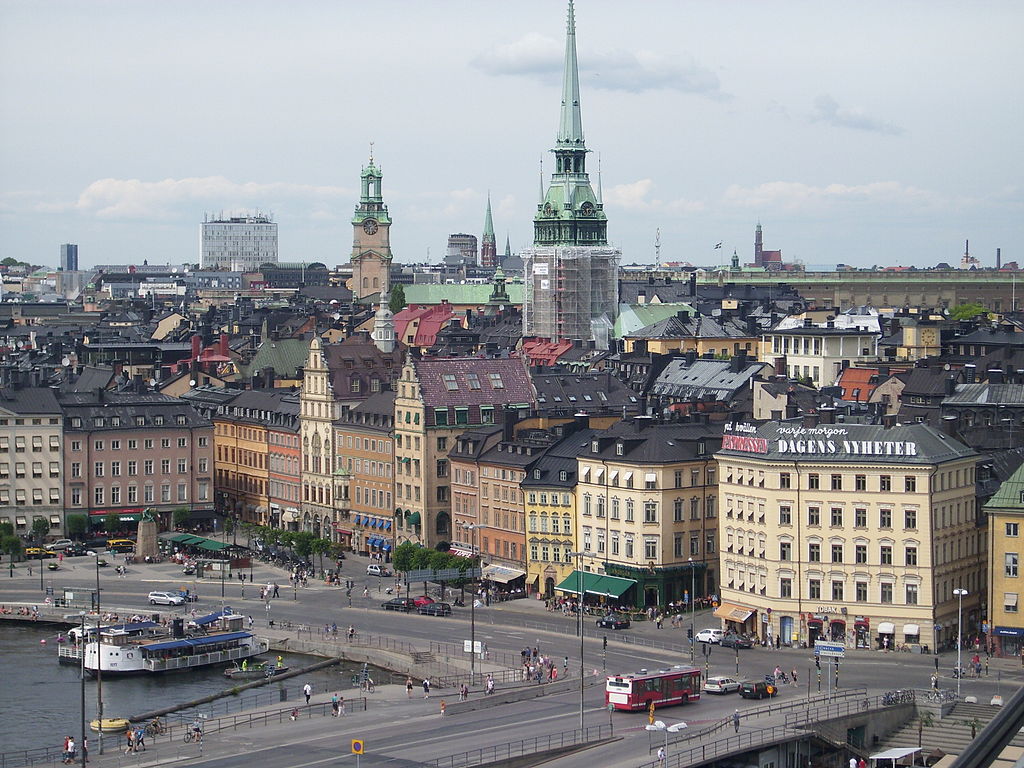
1. Gamla Stan
The Gamla Stan is the most popular neighborhood in Stockholm for tourism. Its located on a densely packed island at the center of the city, and it is the oldest continually inhabited part of Stockholm. It contains many important sites such as the Nobel Prize Museum, The German Church, and the Royal Palace of Stockholm.

2. Östermalm
Östermalm is another historic neighborhood in the middle of Stockholm that was mostly built up in the late 19th and early 20th centuries. The main waterfront street is known as the Strandvägen. Although it doesn’t contain any of the city’s main attractions, it’s still a popular spot for bars, restaurants, and nightlife.

3. Södermalm
Södermalm is a neighborhood located on an island of the same name, located to the south of the Historic Center of Stockholm. It’s known as the “hip and trendy” neighborhood within the city, and it’s home to many artists and students. The neighborhood also features several steep cliffs which offer commanding views over the rest of Stockholm.
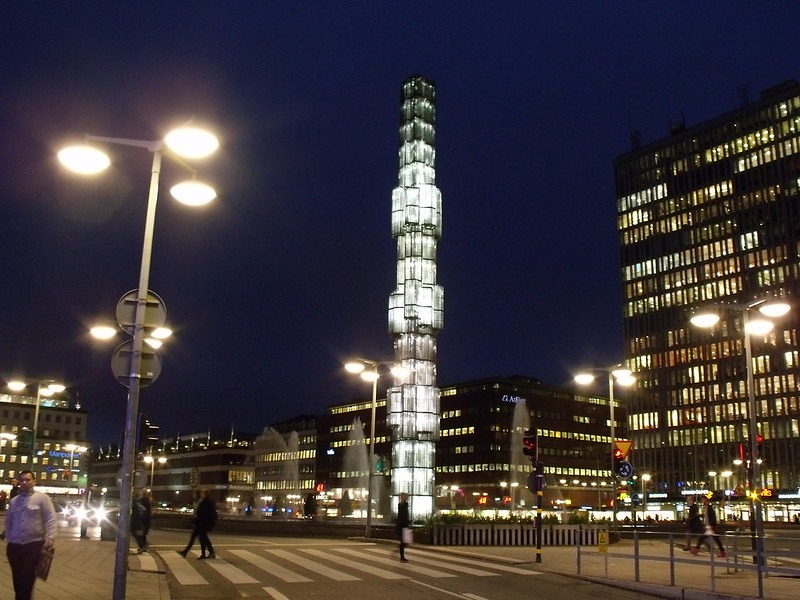
4. Norrmalm
Norrmalm is one of the more modern neighborhoods in Stockholm. It’s where a lot of the city’s offices and businesses are located. The neighborhood is popular with tourists because it has many large hotels and is easily accessible from Stockholm Central Station. Some of the main sites in the Norrmalm include the Sergels Torg and the Drottninggatan Pedestrian Mall.

5. Kungsholmen
Kungshomen is another one of Stockholm’s many Islands. Its located to the west of the Norrmalm Neighborhood, and the two are connected by several different bridges. Kungsholmen is known for its many public buildings, such as the Stockholm City Hall and the Stockholm Court House.

6. Djurgården
Djurgården is one of the largest and most underbuilt islands within the Stockholm Archipelago. Originally it was a hunting ground for the king to hunt deer and elk. Today much of the island is still a greenspace and park. The Island also contains some of the greatest museums in Stockholm such as the Vasa Museum and the Nordic Museum.
Architecture of Stockholm: In Review
Stockholm is one of the most iconic cities in Scandinavia and it contains incredible works of architecture spanning many ages. One can get lost in the Gamla Stan, looking at the many Hanseatic Style buildings that date from as far back as the Gothic Age. There are also many fantastic examples of Baroque Architecture from when Stockholm was the capital of the most powerful empire in the Baltic Region. Stockholm also is home to some of the greatest Revival and Neoclassical Architecture rivaling other nations that are famous for these types of buildings such as the United States, France, and Russia. The city is also a hotspot for modern architecture, and buildings like the Vasa Museum and the Stockholm Metro Stations set the city apart from many other European Capitals. The abundance of both old and new architecture shows that Stockholm is a leading destination for any architecture lover or building enthusiast.
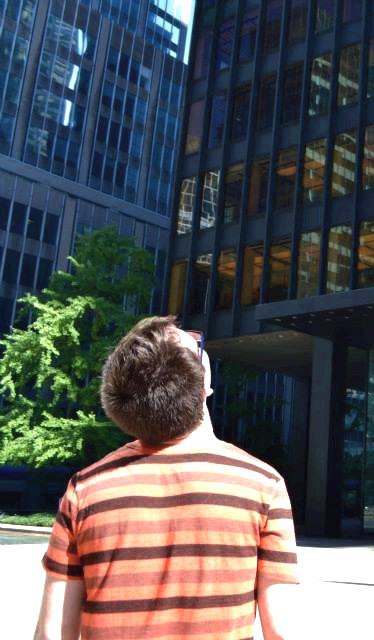
- About the Author
- Rob Carney, the founder and lead writer for Architecture of Cities has been studying the history of architecture for over 15 years.
- He is an avid traveler and photographer, and he is passionate about buildings and building history.
- Rob has a B.S. and a Master’s degree in Architecture and has worked as an architect and engineer in the Boston area for 10 years.
Like Architecture of Cities? Sign up for our mailing list to get updates on our latest articles and other information related to Architectural History.

Photo by Raphael Andres from Wikimedia Commons
